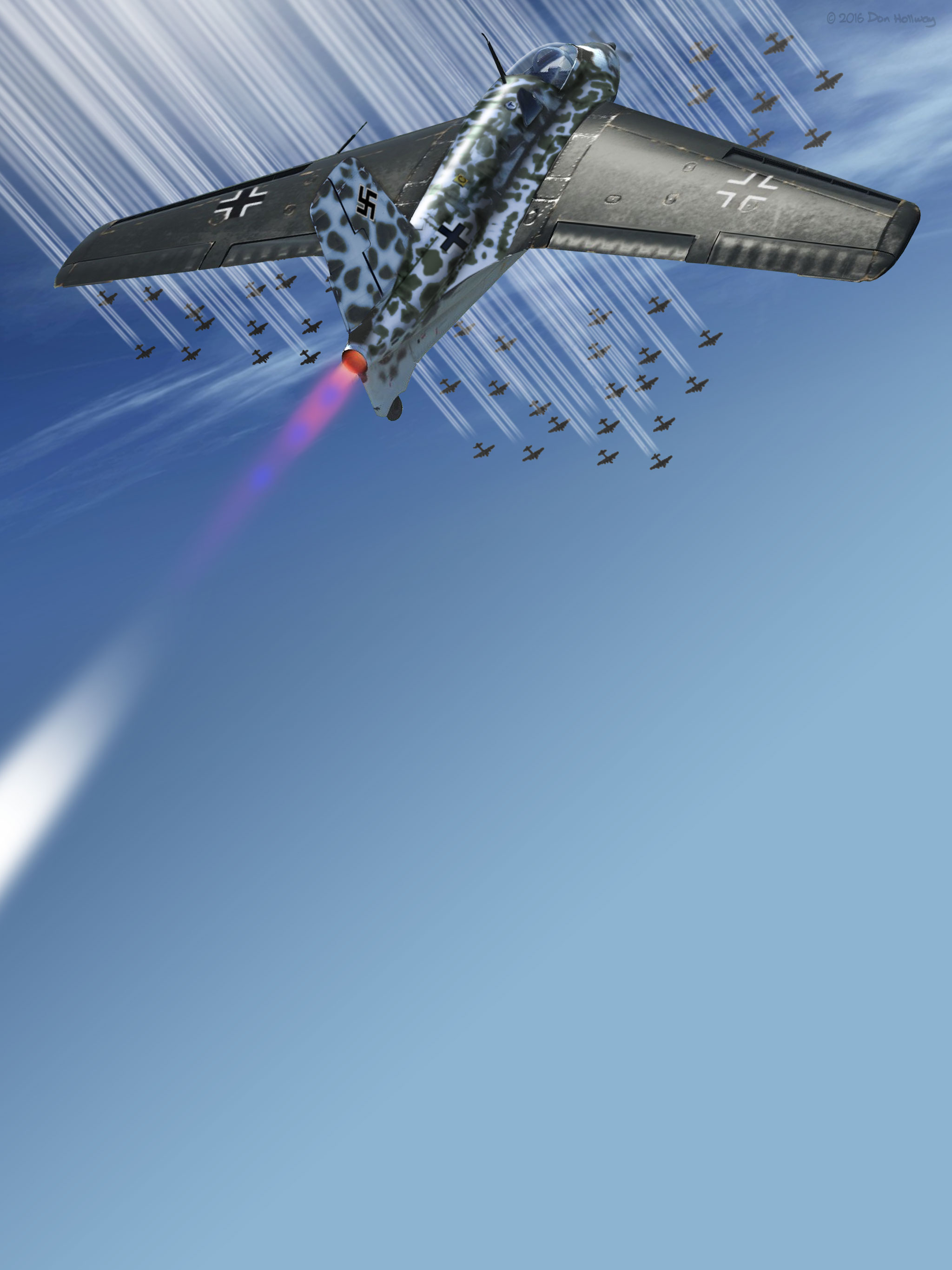



BAT OUT OF HELL
The Messerschmitt Me-163 Komet rocket interceptor outperformed every WWII combat plane...if its pilots lived to fight
|
by DON HOLLWAY 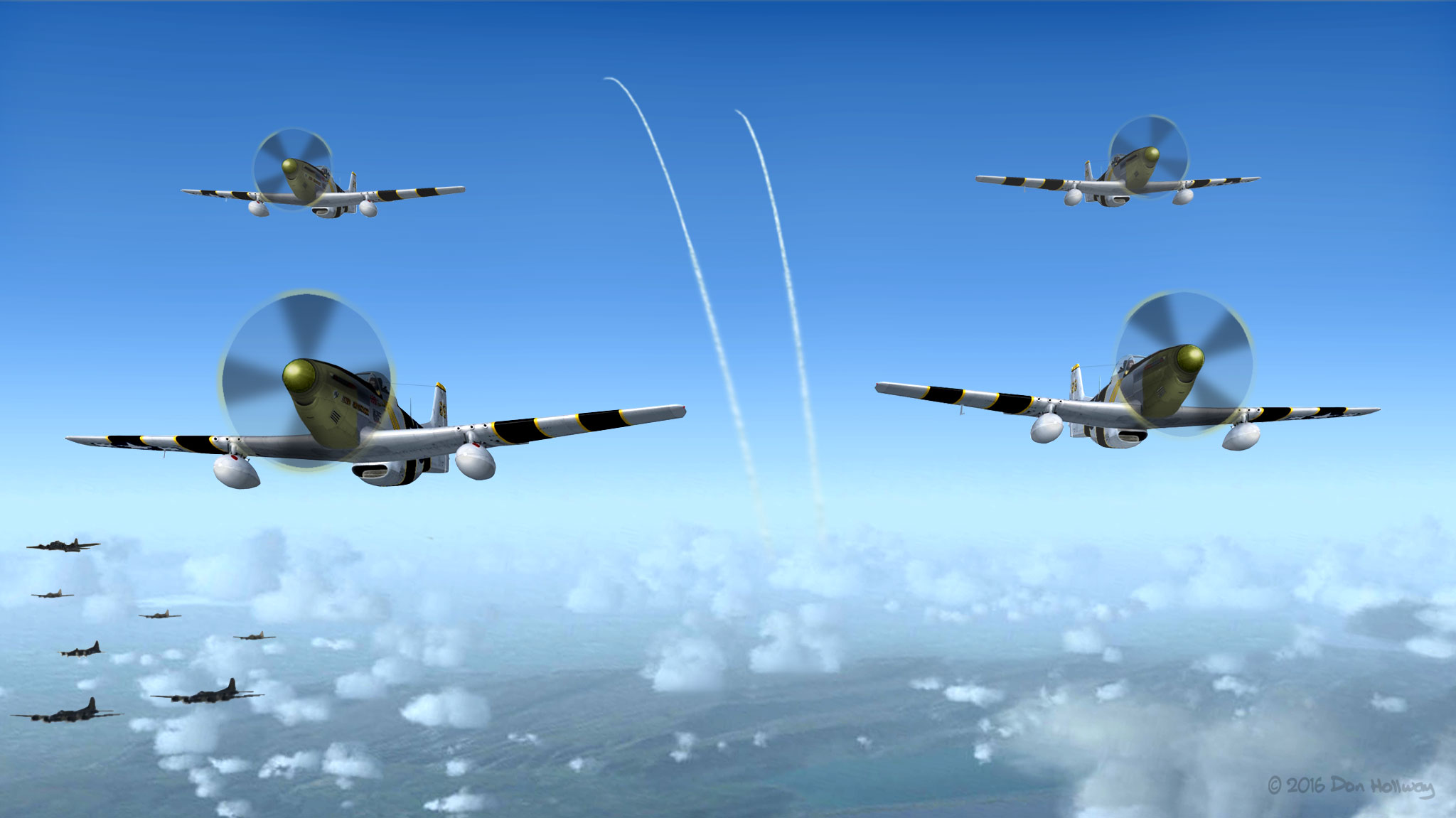
In late July 1944, Mustang pilots thinking they ruled the skies over Germany got a nasty shock. Col. Avelin P. Tacon Jr. of the 359th Fighter Group reported, “My eight ship section was furnishing close support to a Combat Wing of B-17s that had just bombed Merseburg. The bombers were heading south at 24,000 feet and we were flying parallel to them about 1,000 yards to the east at 25,000 feet. Someone called in contrails high at six o’clock.” Already more than a mile above Tacon’s Mustangs, two stubby, tailless, swept-wing single-seaters dived to the attack. “When they were still about 3,000 yards from the bombers they saw us and made a slight turn to the left into us, and away from the bombers,” Avelin recalled. “Their bank was about 80 degrees in this turn, but they only changed course about 20 degrees.... Their rate of roll appeared to be excellent, but radius of turn very large. I estimate, conservatively, they were doing between 500 and 600mph.” The intruders slashed past the American formation. One dived away, the other climbed into the sun, as another 359th pilot put it, “like a bat out of hell,” and that quickly they were gone. “Although I had seen them start their dive and watched them throughout their attack,” Tacon admitted, “I had no time to get my sights anywhere near them.” 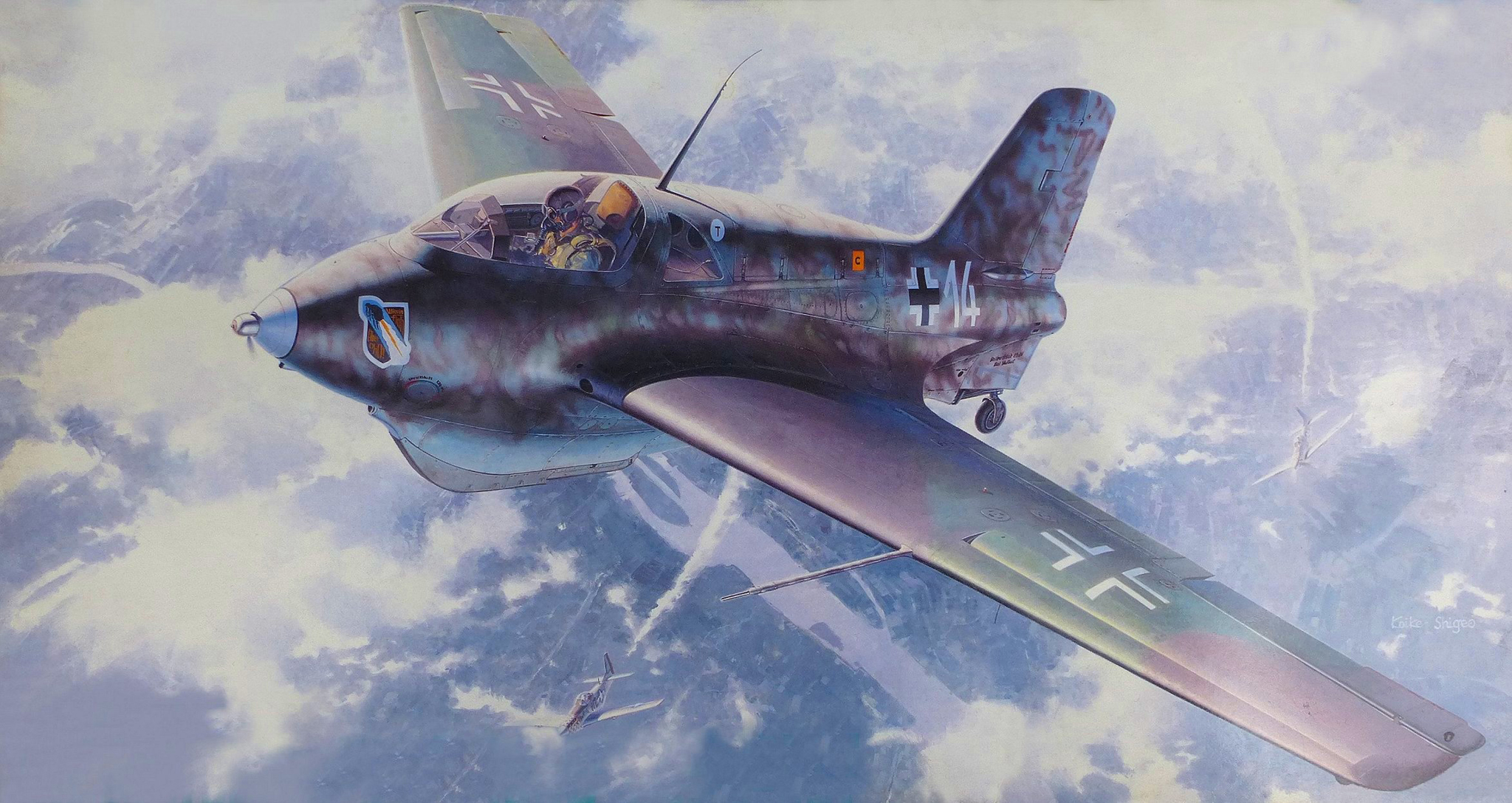
Messerschmitt Me 163B 1a Komet by Shigeo Koike 1944 was the year of the Wunderwaffen, German wonder weapons. King Tiger tanks. Jet fighters. Helicopters. Guided missiles. Cruise missiles. Prototype ICBMs. Railway guns. Long range superguns. Spurred by the specter of imminent defeat, projects that had been years in development were suddenly given highest priority, accelerated into production, and put into service. Having evolved since the 1920s, the rocket fighter would prove one of the more successful ventures. Whether it proved combat-worthy would be another matter. 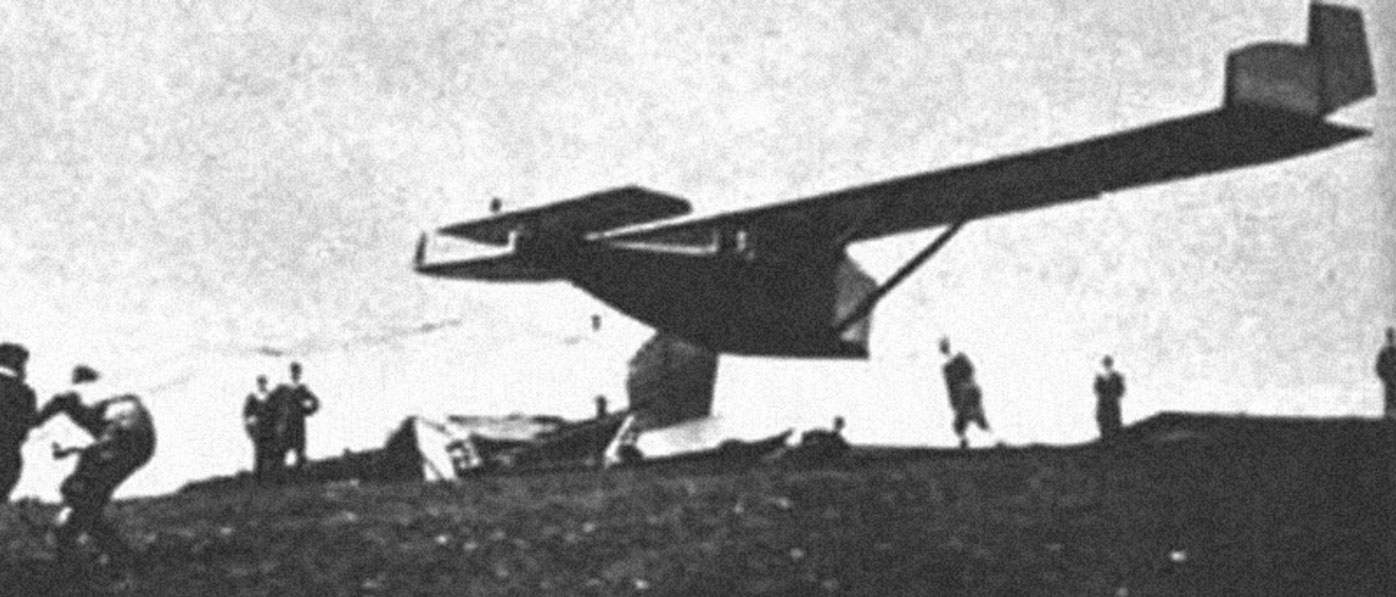
First rocket-powered flight: 11th June 1928 Fritz Stamer in the Lippisch Ente (Duck). It was powered 8.8 pound sticks of black powder, ignited sequentially from the cockpit, each delivering 30 seconds of thrust. The first attempt failed when one of the rockets burned out. On his second attempt, shown here (launched with a bungee cord), Stamer flew about .9 mile around the Wasserkuppe, the highest peak in the Rhön Mountains. The flight lasted only about 80 seconds. On a third attempt, one rocket exploded and the Duck caught fire 65 feet in the air. Stamer put it down and jumped out unharmed, but the Ente burned to the ground. It was the Allies themselves who had forced the Germans into thinking outside the box. The Versailles Treaty ending WWI, which forbade Germany powered single-seat aircraft (i.e., fighter planes), forced its scientists, engineers and pilots into gliders and rocketry. The Wasserkuppe, the highest peak in the Rhön Mountains, served as proving ground for self-taught aerodynamicist Alexander Lippisch’s innovative flying-wing gliders. Carmaker Fritz von Opel, who liked rocket-powered cars for publicity stunts, bought Lippisch’s “Ente” (Duck) sailplane and equipped it with black powder rockets. On June 11, 1928, just 25 years after the Wright brothers proved powered manned flight was even possible—and 11 years before jet propulsion became a reality—flight instructor Fritz Stamer flew the rocket plane nearly a mile around the Wasserkuppe. On his next attempt, however, one of the fuel sticks exploded. “The four kilograms of black powder flew out and immediately caught the plane on fire,” Stamer remembered. He put down and got out alive, but the Duck was a total loss. When the German military reasserted itself, it looked into liquid-fuel rockets that could be shut off and re-lit. Wernher von Braun favored burning methyl alcohol with liquid oxygen, then in short supply. Engineer Helmuth Walter preferred less volatile, more plentiful hydrogen peroxide—not the dilute H2O2 available at the corner drugstore, which fizzes when sterilizing a scratch, but 80%-pure “T-Stoff.” Reacting with “Z-Stoff,” a catalyst such as calcium or potassium permanganates mixed in water, it decomposed near-explosively into high-pressure steam at 800° C. It also spontaneously ignited any organic material it touched, and dissolved human flesh. “If you stick your finger in it,” Lippisch warned, “then you get only the bone out.” 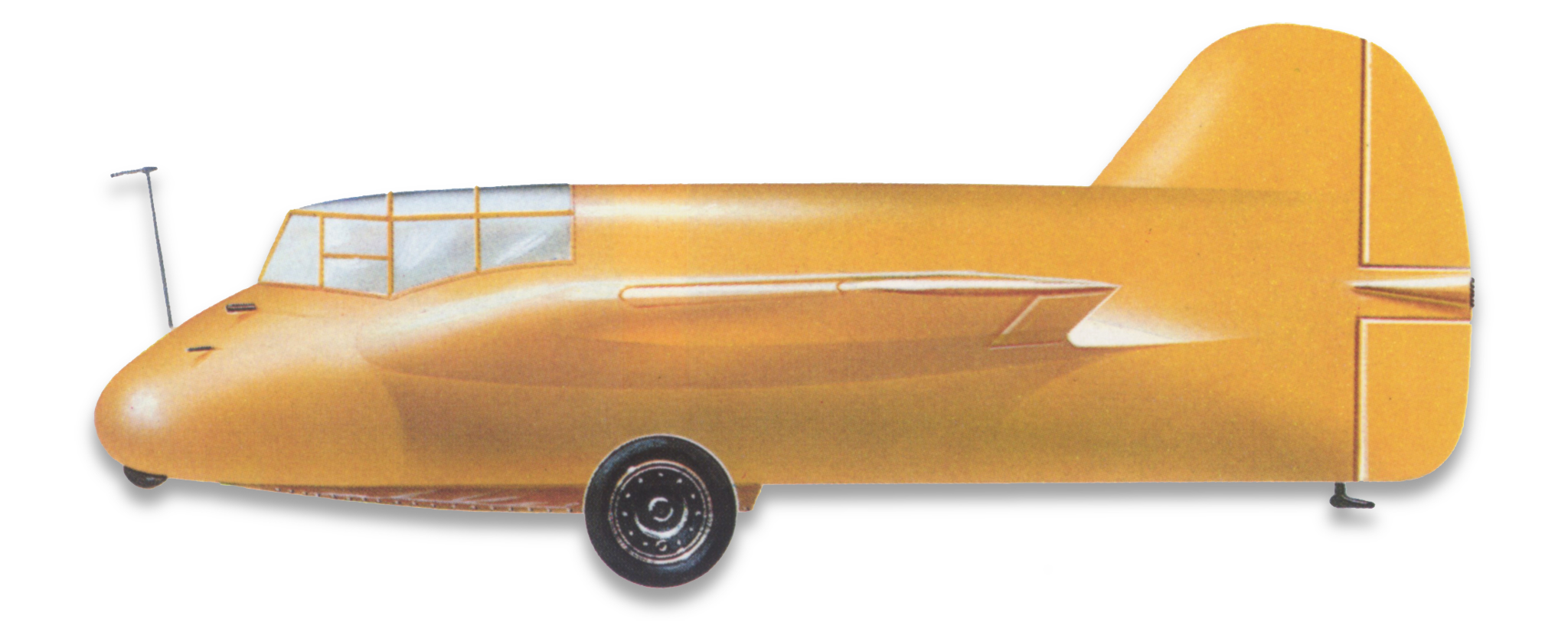
DFS 194 V1, the prototype for the Me-163. Flown at Peenemünde-West, winter 1939-40. Photo Von Braun’s idea for a vertical-takeoff fighter was rejected. Ernst Heinkel’s tiny He-176 prototype used Walter’s rocket, but could provide only 40 seconds of thrust; Reichsmarshal Hermann Göring dismissed it as a “nice little toy.” Prior to war, no pressing need was foreseen for a rocket fighter. Development slowed. Come the summer of 1941 it was a different story. “Papa” Lippisch, by then working at Messerschmitt, installed a Walter rocket in his “Project X”: a tailless delta airplane, the Me-163A. Me-163A testing (Silent) With a wingspan slightly less than the Me-109 (30.5 feet), the 163 had 18% more wing area; even unpowered, it boasted a glide angle of 1:20. (Modern hang gliders only achieve 1:15, though wide-winged sailplanes can do up to 1:60.) Its swept wings were not so much for streamlining (high-speed airflow being still little understood), but to put the control surfaces sufficiently rearward like fins on a dart. “The unique aileron/elevator on the Me-163 is an inherently stable flying surface,” enthused one of Lippisch’s engineers. Lippisch’s favorite glider pilot, Heinrich “Heini” Dittmar, declared, “It just won’t spin. A child can fly it.” Me-163A V1. 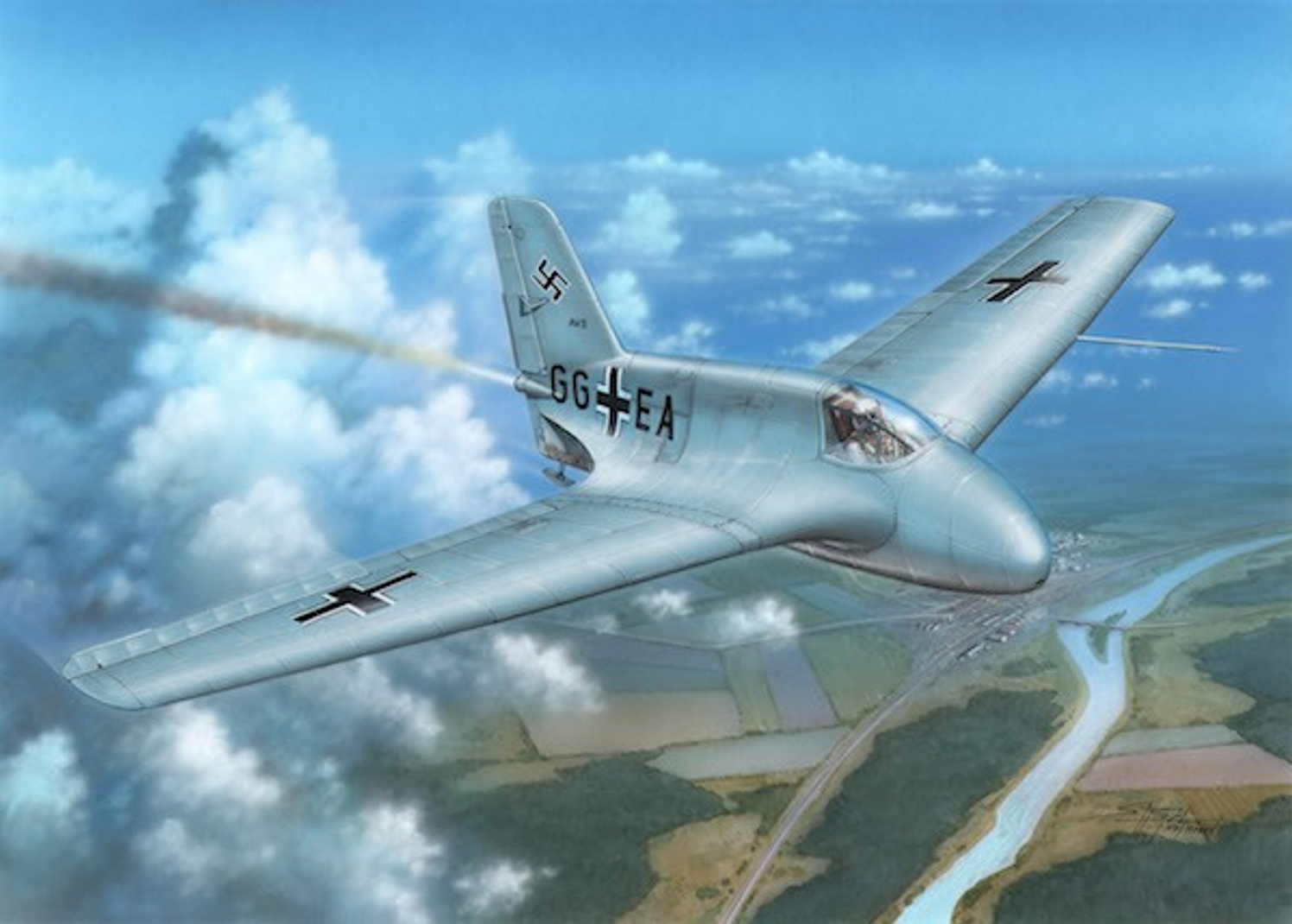
Me-163A V5 made its first gliding flight on 8 November 1941 and first powered flight on 10 or 13 August 1941. Later burnt out at Peenemünde. 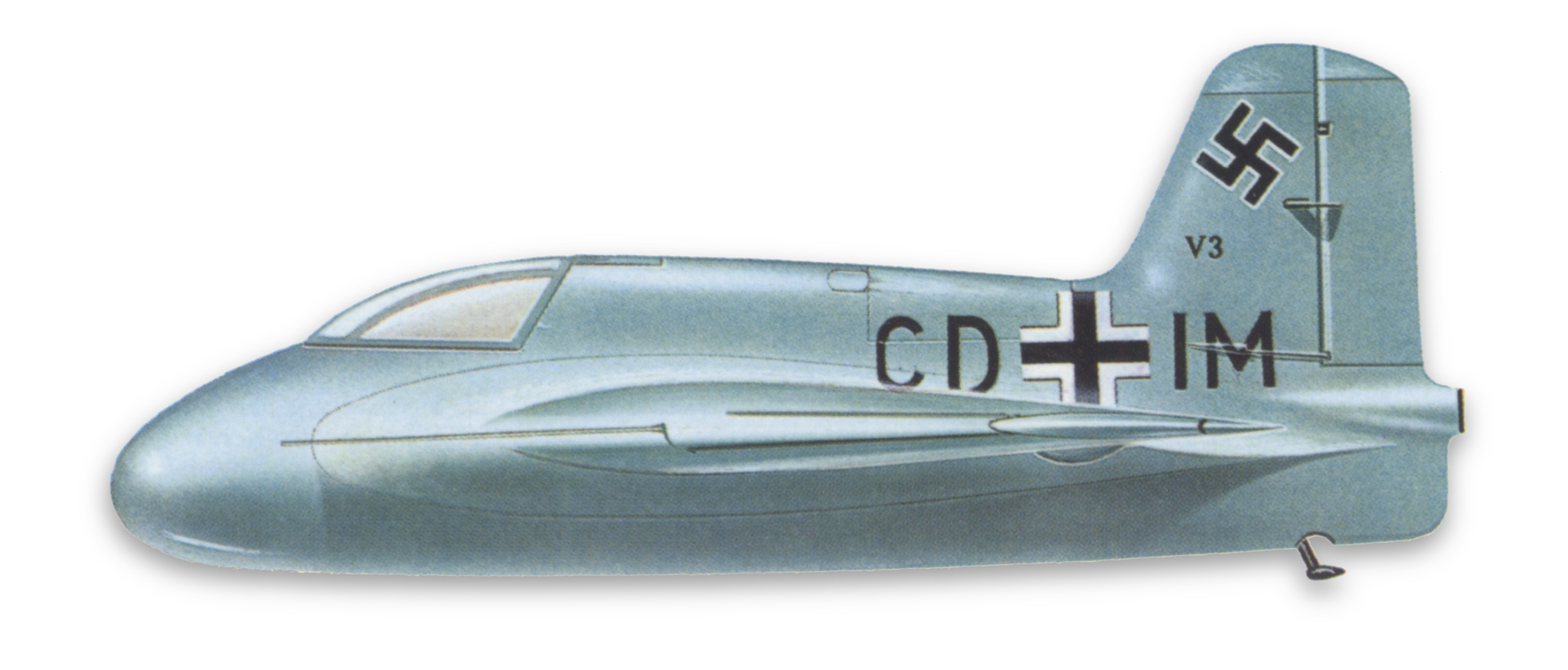
Me-163A V3. On October 3, 1941, test pilot Heinrich “Heini” Dittmar flew this prototype to a new speed record of over 1000km/h And it was fast. In one of the first unpowered glide tests, Dittmar hit 528mph in a dive. Even though it burned most of its fuel just taking off, the 163A climbed at 4,000 meters per minute and easily broke all existing speed records. On October 2nd, 1941, Dittmar had an Me-110 tow him up over 13,000 feet with a full fuel load, cast off, and hit 1,003.67kph (629mph, about Mach .84) in level flight. “And then, things started to happen,” Dittmar recalled. “...The airplane was being pushed down by an incredible force. It took everything I had just to keep my hand on the stick. Some junk floated up from the floor of the cockpit, passed my face and stuck to the canopy.... The engine quit!” Compression shockwaves had caused airflow over the wing to actually exceed the speed of sound, producing negative lift, which killed fuel flow. Despite -11g, Dittmar managed to pull out and re-light the burner. His speed record, initially top secret, would stand almost six years. 
Me-163A CD+IM (center) which set the airspeed record The 163’s aerodynamics were almost too good. At anything over 400kph airflow held the clamshell canopy shut, making bailouts problematic. Veteran Wasserkuppe pilot Lt. Rudolf “Pitz” Opitz, who had flown DFS-230 gliders in the invasion of Belgium and now backed Dittmar as second test pilot, remembered, “The canopy would float one inch over the frame. It wouldn’t blow off.... We took a broomstick along to try to push up the nose section of the canopy to get it out in the slipstream and make it break off.” With its low fuel capacity and relatively low-power motor, the 163A—“Anton”—could only reach 16,000 feet, not enough to reach high-flying Allied bombers. Lippisch’s Me-163B, the “Berta,” was bigger, easier to produce, and could carry more fuel, not to mention wing guns. Whereas the 163A’s “cold” rocket burned at 800°, Walter was developing new “hot” motor, burning T-Stoff and C-Stoff (30% hydrazine hydrate solution in methanol) at 2,000°. While big prop-driven fighters topped out around 2,000hp, at low level the little 163B had the equivalent of 4,500hp, and in thin upper air, up to 9,000hp. However, shortages of C-Stoff and reliability problems—thrust cut-outs, explosive combustion chamber failures—would delay deliveries of the “Hell Machine” by a year. In the spring of 1942 Eprobungskommando (Operational Trials Command) 16 was formed to train rocket-fighter pilots. Prewar gliding champion Captain Wolfgang Späte, now a top ace with Jagdgeschwader 54 on the Russian front with 80 victories and Oak Leaves to his Knight’s Cross, was given command. “Air defense of the homeland is going to be important,” General of Fighters Adolf Galland told him. “...I want to bring the Me-163 to combat-ready status as quickly as possible.” The unit set up shop at Peenemünde, the top-secret test site on Germany’s Baltic coast. As adjutant Späte brought in his best friend, blue-eyed Viennese Lt. Josef “Joschi” Pöhs, a 43-victory ace with JG54 but still on crutches after bailing out of an Me-109. “I was able to drag him out of his sickbed in a flash with only a few hints about testing a rocket fighter,” Späte recalled. “...He was sure he could move his feet around enough to move a rudder. He still couldn’t depress the brake pedals, but that wasn’t necessary. The Me-163 didn’t have any.” On May 11 Späte climbed into the same Me-163A that Dittmar had used for his speed record seven months earlier, but this time for a “sharp start,” a rocket-powered takeoff. “An Me-109 accelerated better under full power, but with a propeller, the acceleration decreased as the speed increased,” he remembered. “Here the acceleration was constant.... When I pulled the handle and the wheels fell away, it felt like I had just dug in my spurs.... Now all I had to do was follow Dittmar’s instructions and keep the airspeed at 400km/h. To do it, I had to continually pull back on the stick. My attitude kept increasing until I was climbing at 45 degrees. Even then, the airplane wanted to accelerate.” Its handling amazed him even more. “Despite its unique tailless planform, the Me-163 was stable in every axis. This meant that at high speeds you could effortlessly make any course correction, in any direction, something that is of major significance for a fighter plane and is quite often lacking in other faster airplanes.” 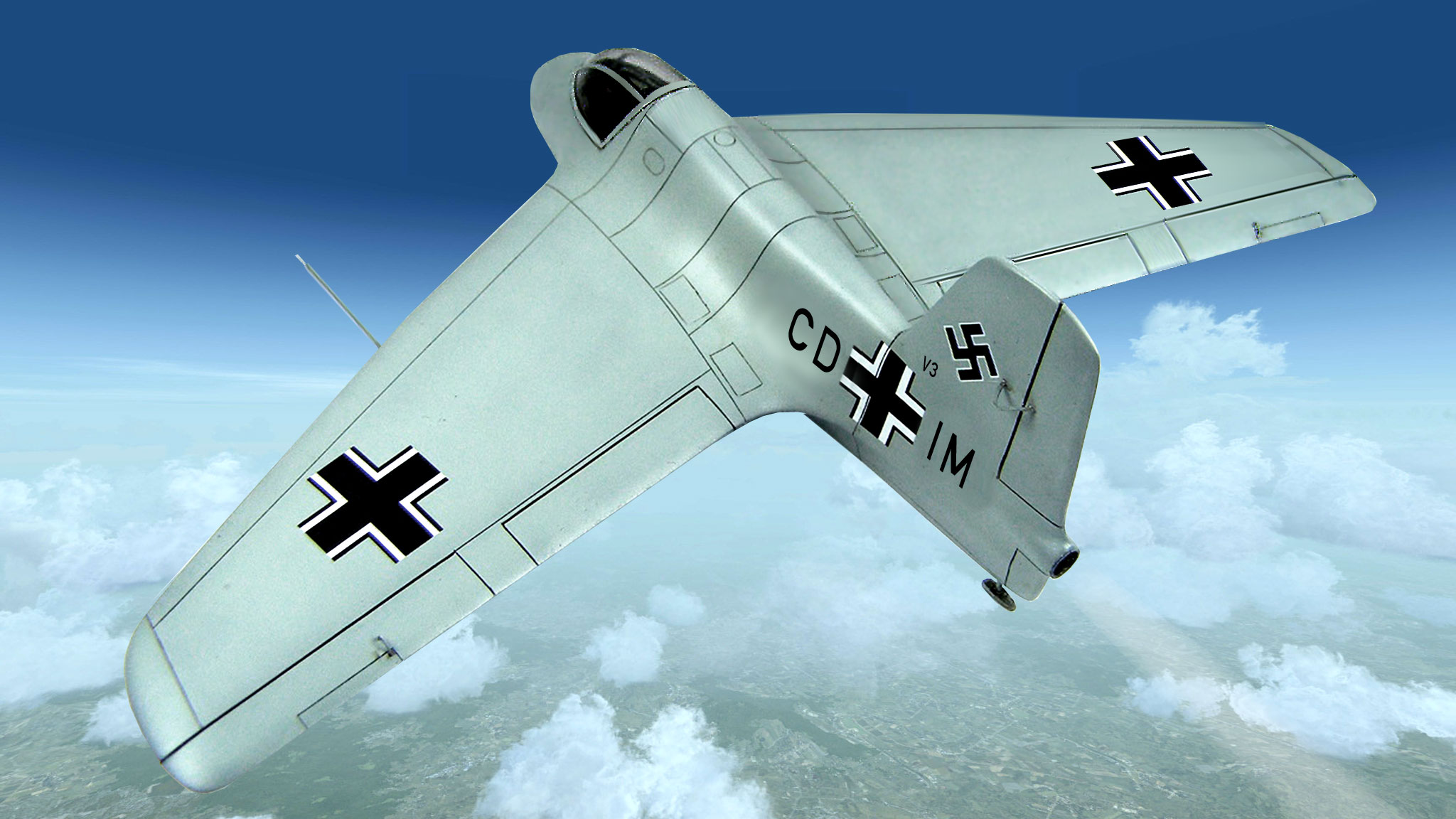
“I found this creation of Lippisch to be an aircraft with flight characteristics so beautifully balanced that I have seldom flown one like it, either before or after this flight.... In reality, we have a flying tailless Interceptor, an aircraft capable of 1,000km/h, and one which will hopefully swing the tide of the air war in our favor.” Training for rocket fighters was unlike that for any other aircraft. Pilots went through several weeks of high-altitude conditioning atop the 9,700-foot Zugspitze in Bavaria. Rocket ascents were so rapid that in the unpressurized cockpit pilots got a touch of the bends, similar to that experienced by deep-sea divers surfacing too quickly, as nitrogen bubbles began to expand in their bloodstreams. They acquainted themselves with the itching, trembling effects and those of oxygen deprivation in a captured Russian pressure chamber. Meals were restricted to a special “altitude diet” to reduce intestinal gas, lest they blew up like balloons. 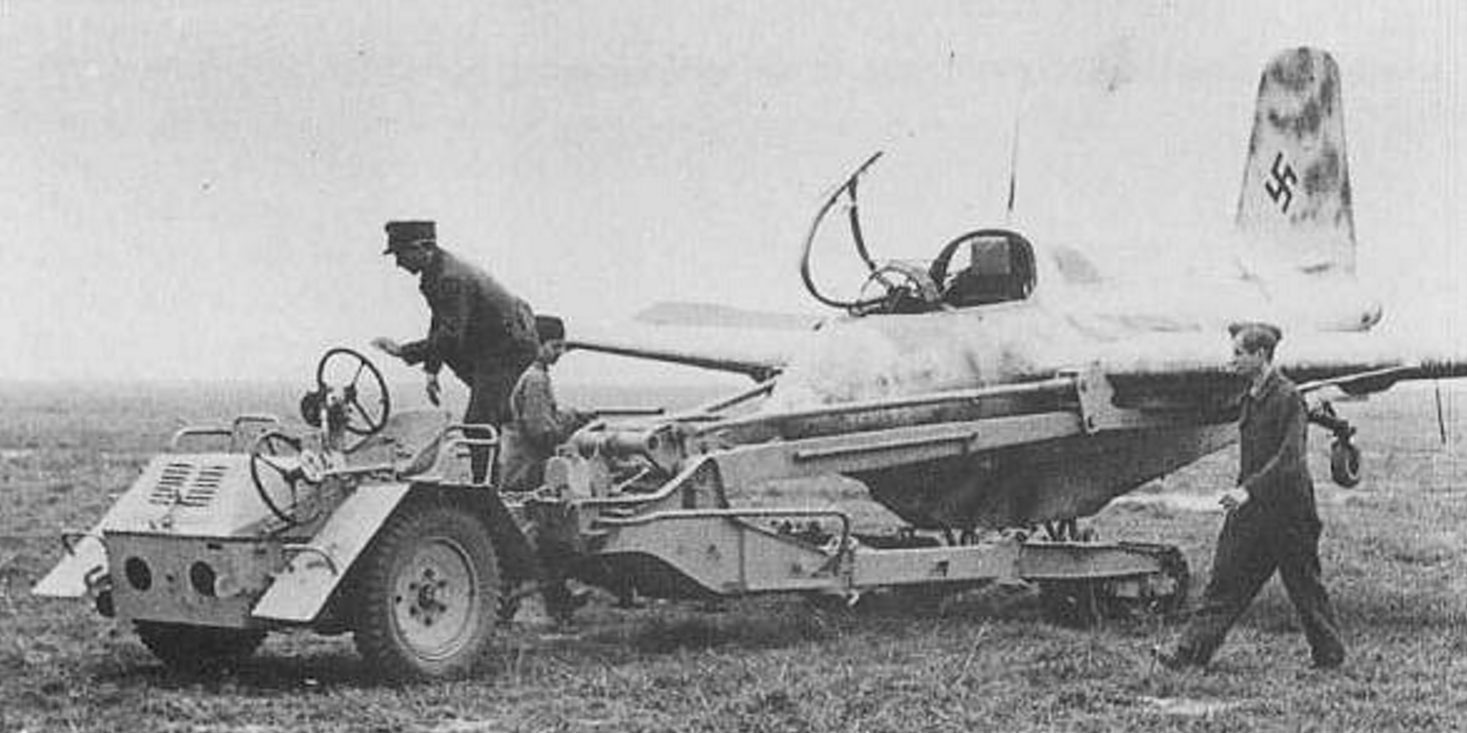
Late-model Scheuschlepper. Early models used inflatable air bags to lift the Komet But if the 163 was a sweetheart in the air, it was a devil everywhere else. As with his sailplanes, Lippisch believed wheels were only necessary on the ground. 163 pilots dropped their main gear soon after takeoff and landed on an extendable belly skid. The dolly, neither shock-absorbing nor steerable, required operations off wide grass fields, since without steering a concrete strip would only have been useful if the wind was blowing along it. A combination tow motor/forklift, the Scheuschlepper (Shy Tug), retrieved it from the field, at first lifting it on airbags inflated under the wings. If the rocket cut out at low altitude, pilots were warned not to try to bank or turn with a full fuel load, but to put down straight away. “If at all possible,” suggested one, “heading straight into the cemetery to save expenses.” Rudi Opitz tests the 163B with a helmet-mounted camera (Silent) With all that wing area the 163 tended to float on landing. High landing speeds (100mph in the Anton and 137mph in the “Berta”) made overshoots common. On unprepared ground the belly skid often dug in like a plow; nor did it much soften a hard landing, as Dittmar learned when he stalled a Berta at 12 feet and slammed it down on concrete. Its skid collapsed. The shock went straight to his spine. With his fifth thoracic vertebra broken, Dittmar was grounded for two years. He was lucky. Me-163 pilots quickly became experts at dead-stick landings, or they died. It being absolutely critical that T-Stoff and C-Stoff never came together except in a combustion chamber, there were separate handling crews for each. T-Stoff, which corroded iron and steel, had to be kept in aluminum tanks, but C-Stoff ate through aluminum, and had to be kept in glass or enamel. All T-Stoff containers were white; all C-Stoff containers yellow. Fuel trucks, clearly marked T or C, were forbidden to come within 800 meters of each other. Pilots wore flight suits of synthetic fiber polyvinylchloride impervious to T-Stoff, at least until it leaked in through the seams. Heini Dittmar and Hanna Reitsch with Me-163 (Silent) Despite the difficulties, or because of them, the challenge of rocket flight was undeniable. Famous aviatrix Hanna Reitsch, the German Amelia Earhart, used her friendship with Adolf Hitler to wrangle rocket flights in the Anton and glide flights in the Berta. On October 30, 1942, on her fifth flight in a Berta, its undercarriage dolly refused to separate. Reitsch missed the runway, came down across the grain of a fresh-plowed field and dug in, banging her face on her gunsight, breaking her cheeks, jaw and skull and almost tearing off her nose. Though she spent six months in the hospital, she still insisted on being the first to fly a sharp start in the B. Späte (who thought her a primadonna) forbade her to further risk herself. She never flew it again. By 1943 Peenemünde was the wunderwaffe capitol of the world. Along with the Me-163, radio-guided and wire-guided glide bombs and the V-1 cruise missile were being tested. Späte’s pilots watched the first test shots of the V-2 rocket, one of which heeled over on liftoff and came down on their field, blowing up a pair of five-engine twin-fuselage Heinkel He-111Z tow planes. “Our Me-163 was counted as one of the V-weapons,” Späte remembered. “...V-weapons! Those familiar with the programs knew with secret horror that, of all the new weapons, not one was ready for deployment with our combat forces.” The endless delays with the Walter motor had put the rocket-fighter program on indefinite hold. The RLM went so far as to ask BMW to come up with an alternative design burning nitric acid and methanol, which came to nothing. Meanwhile jet-engine technology had caught up and was moving literally full-speed ahead. Späte even test-flew a prototype Me-262. He found it neither as fast nor as maneuverable as his rocket fighter but, with its greater endurance, far more practical. “The Me-163 was a small, polished dagger,” he concluded. “The Me-262, on the other hand, was a large sharp sword.... It was the means to swing the course of the war back to our side.” Disdaining the 163 with a “not invented here” attitude that eventually drove Lippisch from the company—or simply seeing the writing on the wall—Messerschmitt focused on their in-house Me-262 jet. Späte complained, “They believed the Me-163 would probably be the next project to ’get the axe.’” “The Me-163,” Späte learned, “unfortunately doesn’t have the same priority as U-boats, tanks or AAA [anti-aircraft artillery]. And because of it, we continue to experience all these delays.” 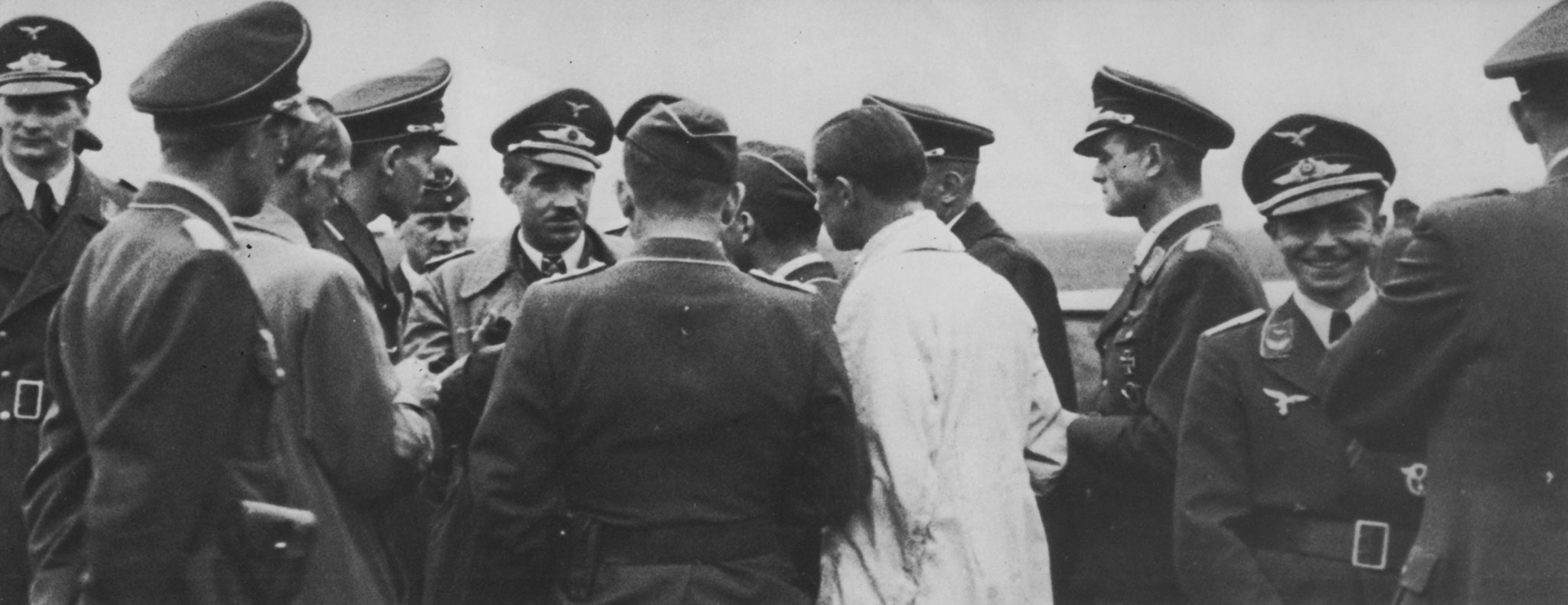
General of Fighter Pilots Adolf Galland (moustache) attends the preview of the Me-163A at Lechfeld, Bavaria. Heini Dittmar in white coveralls, Späte in profile to right, Opitz smiling at camera On Thursday, June 24, almost a year later than planned, and in front of Luftwaffe dignitaries including Galland and Field Marshal Erhard Milch, Luftwaffe Air Inspector General, Opitz made the first sharp start in a 163B with the new Walter rocket. Halfway down the runway, still well below takeoff speed, he hit a bump that lofted the 2-ton plane a dozen feet in the air. On coming back down it tore off its right wheel. With the left banging loose on the fuselage (and a fire truck already setting off after him), Opitz stomped full right rudder and rode the skid for 300 feet before he lifted off, dropped the remains of his undercarriage, and flew a perfect demonstration flight. When he touched down, eyes streaming with T-Stoff fumes leaked from a ruptured line, Milch awarded him 5,000 marks for dangerous duty. The Me-163B, now called the Komet, was ordered into production. A week later Lippisch left Messerschmitt. 
RAF reconaissance photo of Komets parked at Peenemünde. Black streaks at left are scorch marks left on grass by Me-163 takeoffs The Allies were becoming aware of German rocket research. On July 26 an RAF Mosquito snapped photos of parked, bat-winged aircraft which Allied analysts designated “Peenemünde 20.” Over the night of August 17/18 almost 600 RAF bombers pummeled the base: just a taste of the destruction to be wrought on German cities as the Allied bombing campaign intensified. EK 16 relocated to Bad Zwischenahn, near Bremen. Townspeople, to whom rocket fighters overhead became nothing unusual (they called the Me-163 the “Moth”; pilots nicknamed it the “Thunderbird” or “Powered Egg”) asked, “When are you going to employ your force and sweep the skies clean again?” 
RAF reconaissance photo Komet at takeoff from Peenemünde, with white rocket plume behind plane. Circular objects are filled-in bomb craters. Eleven Me-163Bs were destroyed when the Messerschmitt plant was bombed. Production, farmed out to Klemm and Junkers, was hampered by lack of engines and components. There were critical shortages of C-Stoff, trucks to transport C-Stoff, and tanks to store C-Stoff. Joschi Pöhs resorted to mock-dogfighting student pilots in Fw-190s when they overflew the base. “He so adeptly and skillfully used the turning capability and airspeed of his small rocket bird, as well as the acceleration power of the engine,” approved Späte, “...the student pilots fled for home in their FW-190s.” “The men are dying to do something positive for our air defense,” Pöhs excused. “It’s an impossible situation for them to sit here week after week waiting, while bombers roar over and destroy our cities.” Meanwhile Späte devised operational plans for deploying Komets when they finally arrived. “We should systematically disperse squadron-sized units in a network of suitable airfields,” he recommended to Galland, “...between 60 to 150 miles apart from each other. They should be built in a chain which enemy aircraft will have to fly over.” Me-163B testing (Silent) The first 47 163B-0 models carried one 20mm cannon in each wing root. By 1944 this was already light armament, particularly against big, armored bombers. In the later 163B-1 models the Mk 151 was replaced with the 30mm Mk 108. Finally, late that year, Späte and Pöhs visited Augsberg to test-fly the first production Bertas. Späte suited up in a polyvinylchloride hood, coveralls and overshoes. “I felt like a mummy,” he recalled. “...But wearing the suit gave me the confidence that I had a certain amount of protection against that cursed T-Agent.... The designers had installed fuel tanks (in the wrong place) to the left and right of the pilot’s seat. A simple sheet of pure aluminum separated my legs from two 60-liter tanks gurgling with T-Agent. A small accident on takeoff and you’re sitting in a flesh-dissolving solution.” However, he soon forgot any doubts he’d had about the rocket fighter. “Now I was about to find out what the Walter engine and my little Me-163 actually had in them. After the wheels dropped and the skid retracted, the aircraft really started to step out.” The Anton climbed 45° at 400km/h; the Berta, even steeper at 600km/h. In three minutes it could reach 40,000 feet. “This was a special kind of airplane,” Späte knew, “...an extremely good feeling aircraft, an elegant, lightning fast, easily controllable dart.... I had experienced something today that even the Me-163A didn’t have to offer. You really could intercept any other aircraft with this bird.” His only complaint was an excruciating need to fart: “I swore to myself that I would never again eat pea soup and heavy cornbread before a flight in a rocket fighter.” Späte and Pöhs returned to Peenemünde to await deliveries. On Dec. 30 Späte was doing paperwork in his office when he heard another training flight of FW-190s overhead, then the roar of a 163A taking off. “Pöhs presumably was going to take this opportunity to chase them away,” figured Späte, who remembered suddenly jumping out of his chair. “The sound of the engine had quit abruptly.... The engine must have flamed out shortly after takeoff.... Then an explosion shook the barracks walls and windows as though a bomb had gone off.” 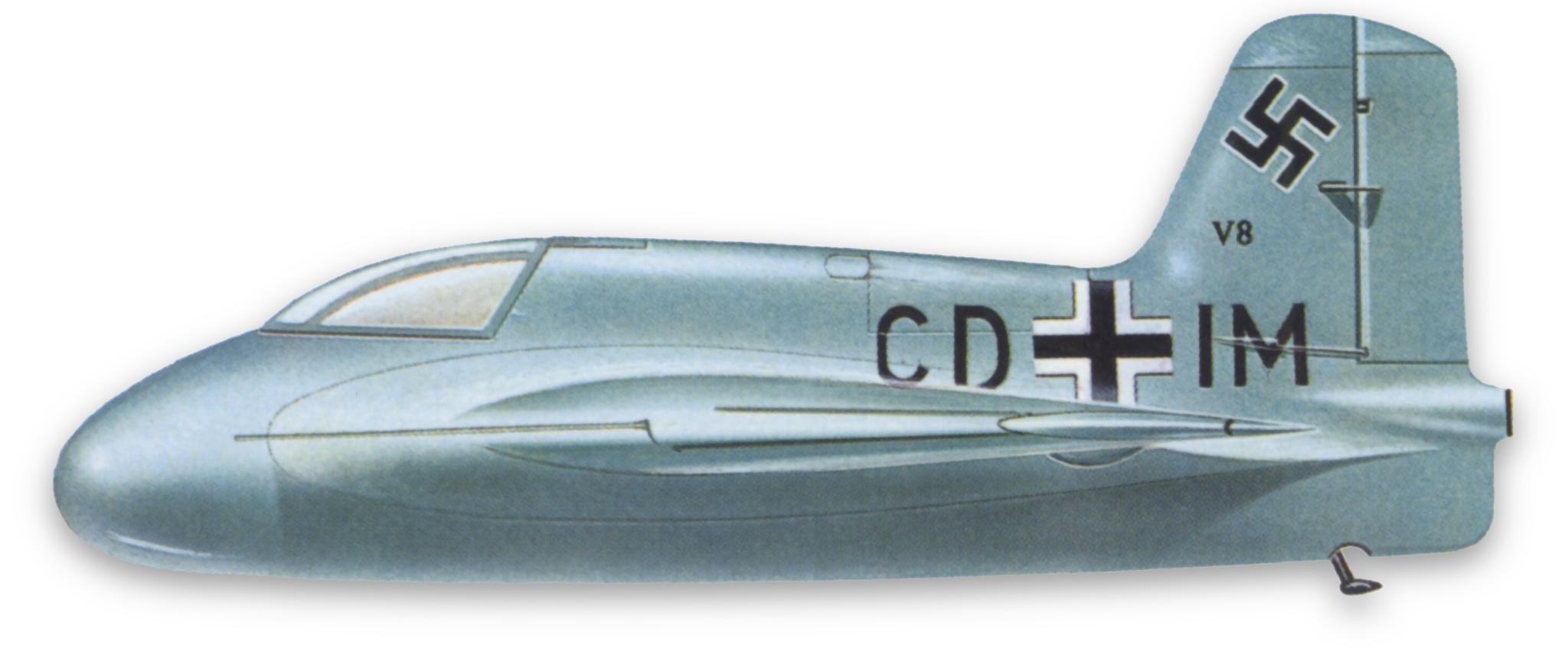
Me-163 V8 CD+IM Späte jumped in a car and raced to the crash site, 1½ miles away on the far end of the field. It was Pöhs. “He had not tried to bail out as the airplane had never got high enough for him to use his parachute. He had succeeded in turning the aircraft back towards the base-among us pilots, that was known as the ’death turn’ since so many have crashed attempting it. But, as he soared in over the landing area, he came face-to-face with a radio antenna. He didn’t have enough controllability left to avoid it. He clipped the tower with a wing tip and the aircraft did what we call a ’pole vault,’ digging a wing tip in the ground and cartwheeling.” The Messerschmitt’s remains lay on its back. “I saw two legs protruding from the broken nose section. They belonged to my best friend! Mindlessly ignoring all regulations, I waded through the [extinguishant] slime and foam to the airplane and looked into the crushed cockpit area. I recognized that there was absolutely no chance of survival.... ’I want everyone who is not directly connected with the recovery operation to leave the scene immediately,’ I ordered.” The accident report concluded that when Pöhs dropped his undercarriage, it had rebounded so hard and high that it stuck the aircraft’s belly, breaking a T-Stoff line and causing the rocket to automatically shut down. Worse was the post mortem report: while Pöhs was trapped in the cockpit, he had been inundated with T-Stoff. “Even though he was wearing a protective suit,” Späte was told, “his entire right arm had been dissolved by T-Agent. It simply wasn’t there. The other arm, as well as the head, was nothing more than a mass of soft jelly.” His friends could only hope Pöhs had been killed instantaneously or at least knocked unconscious in the crash. In January 1944, nearly two years after delivery of the first 163B, EK 16 finally received its first operational models, but “operational” did not mean gremlin-free. The unit spent weeks wringing them out to resolve engine flame-outs and other issues. In February, Späte suffered a ruptured fuel line on takeoff. With his cockpit filling with T-Stoff fumes, his overheat indicator lit up, and his fuel-dump valve lever inoperative, he had to put his flying bomb down on six inches of snow: “The bird started sliding on its steel skid like a skier coming down a well prepared slope.” Before it skidded off the airfield grounds into the trees, Späte popped his canopy and rolled off the wing, sustaining a concussion in the process. “It was unthinkable,” he wrote, “to consider sending a single airplane that had such an unreliable engine into combat, let alone deploying an entire squadron.” 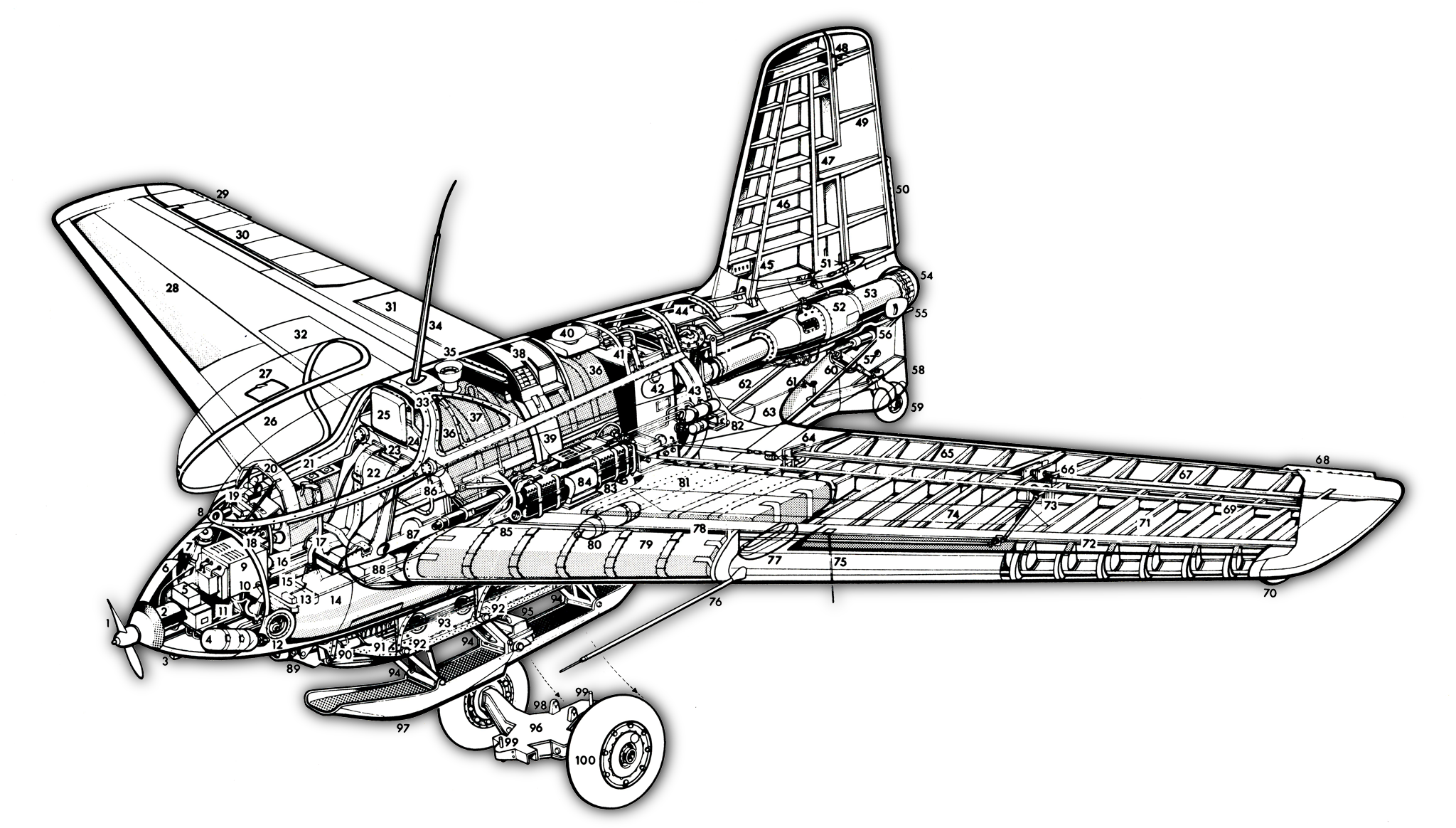
Messerschmitt Me-163B-1a
1 Generator drive propeller
34 FuG 16zy radio receiving aerial
69 Rear wing spar That spring EK 16 was redesignated Jagdgeschwader (Fighter Wing) 400. 1 Staffel (First Squadron) deployed to Wittmundhafen. Opitz, who would eventually command the unit, delivered their first Berta: “When I zeroed in on [the] field for a high-speed low-pass, long strings of tracer bullets came at me from all sides.” Local flak crews had never seen a plane like the Komet. They found it a hard target. “...We took it as a good omen that they had not achieved a single hit at the aircraft.” 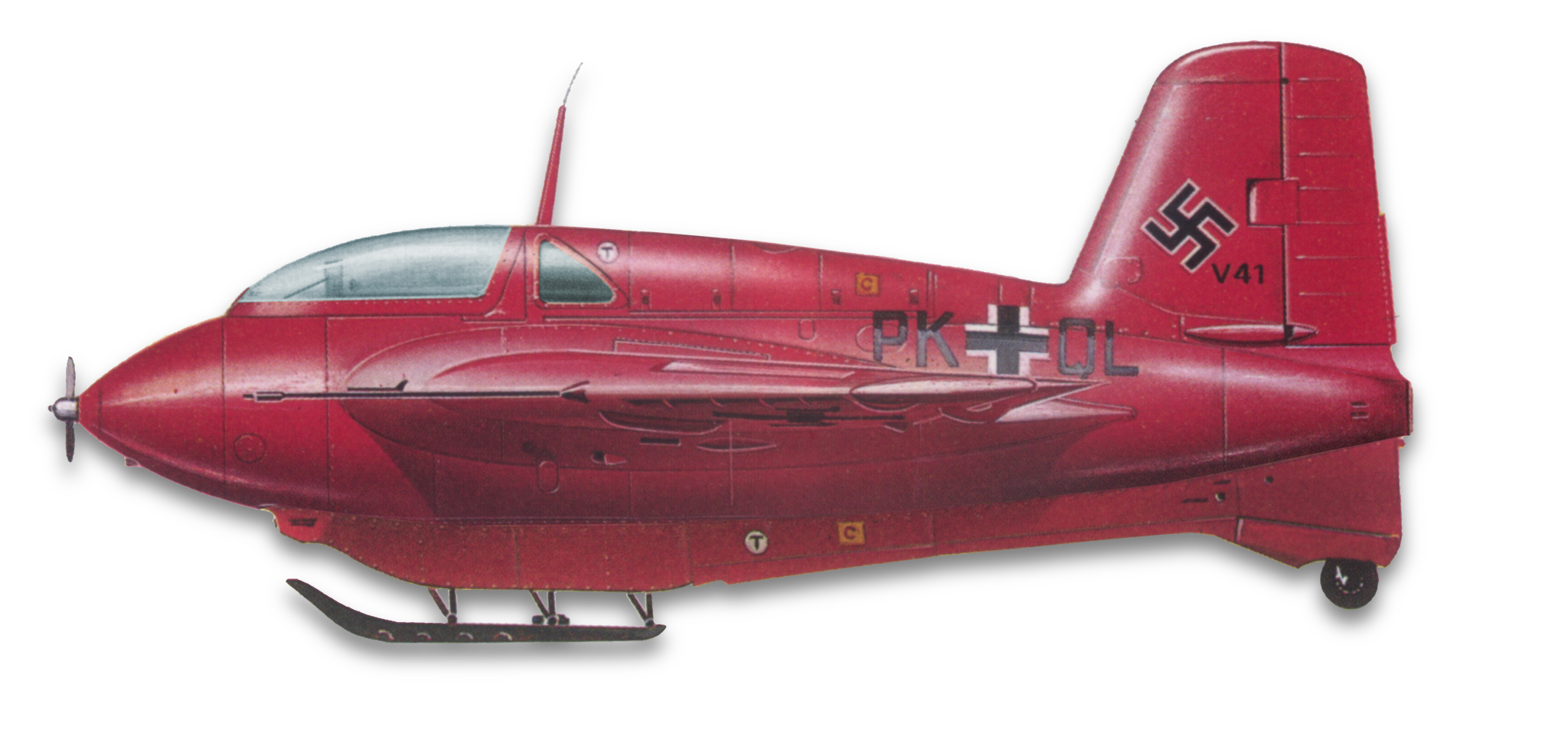
Me-163B-0 V41. On Saturday, May 13, 1944, Major Wolfgang Späte flew this fighter, in this paint scheme, on the world’s first rocket-fighter sortie. It was unsuccessful. It was May before a Komet saw combat. With a lack of enemy around, Späte’s ground crew might be excused for presenting him with a Berta painted all-over Richthofen red. The C.O. was not amused. “If I roared past an enemy aircraft in this get-up at 700 km/h in a steep climb, some naive individual might think I was a phantom from outer space. But when I tried to make it back to the airfield, gliding without a drop of fuel left, I would be easy to see from miles away.” As luck would have it, early that afternoon an incoming Allied formation was spotted on radar, coming into range. Späte scrambled and in minutes rose up under four American fighters: “I had the impression that the two elements were standing still in the air while I was shooting up like a rocket between them.” 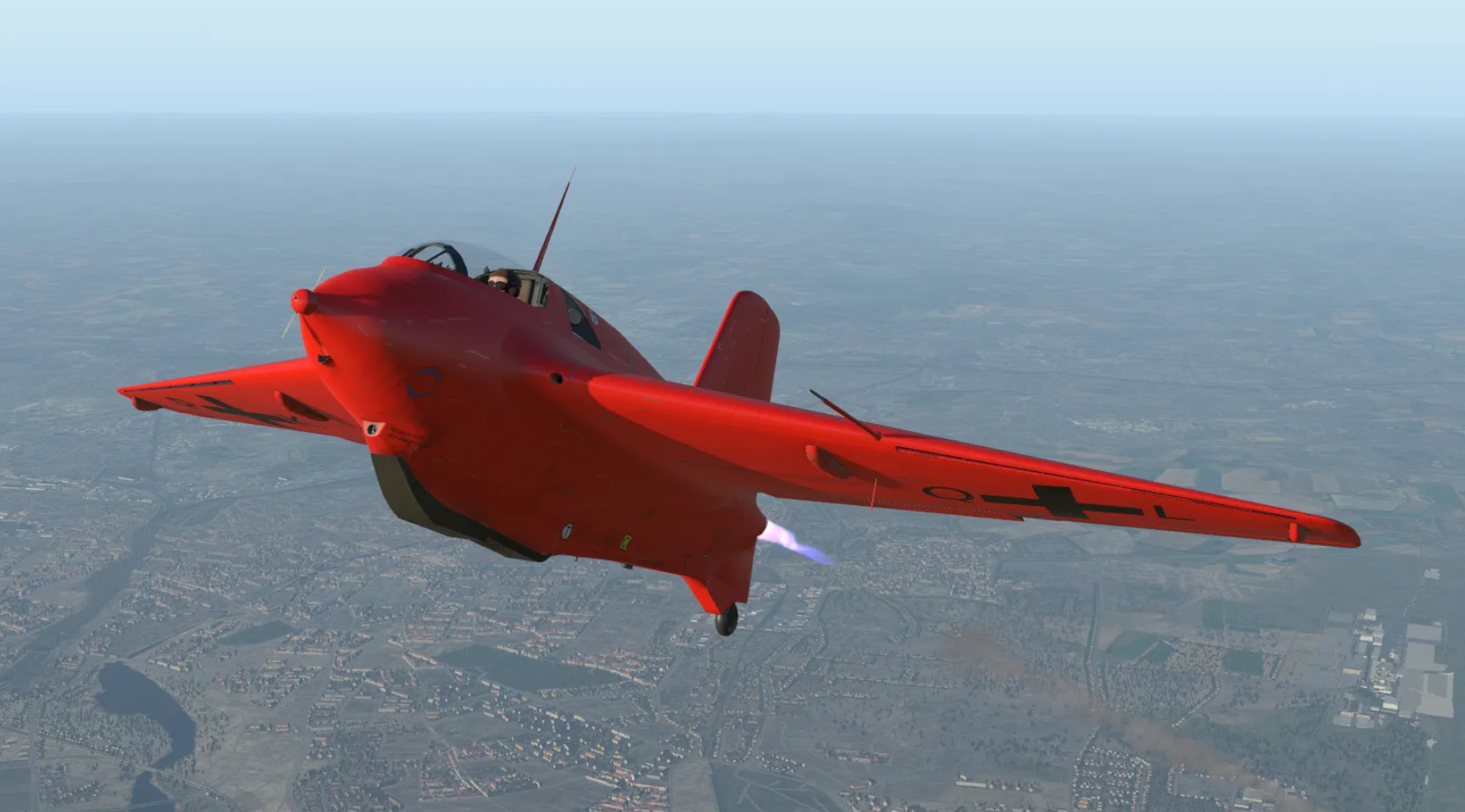
Unfortunately, as he adjusted his climb angle, Späte added a touch of negative g. His rocket promptly cut off. A mid-air relight required two minutes. As the drifting Komet slowed, the Americans, having apparently not spotted the red apparition behind them, pulled away. When Späte re-fired the rocket, he had to hurry to catch up, so much so that his Komet came up against the sound barrier, buffeting and nosing down, forcing Späte to break off his attack: “I’m more than curious to know whatever happened to those pilots who possibly owe their lives to the fact that there was no Mach warning device [in the Me-163].” It was Späte’s high point as a rocket-fighter pilot. A few days later he was informed that his job as head of the test section was at an end. Further Komet development would cease. JG 400 would be sent into combat with their planes as-is. Späte’s experience as a fighter ace was more valuable at the front. Reassigned to JG 54, he conceded, “My assignment to a normal fighter wing probably made more sense than to continue testing a weapons system that would never develop into a major threat.” His replacement, Col. Gordon Gollob, was no novice fighter pilot either—he had been the first ace to reach 150 victories—but disagreed with Späte’s strategy of dispersing Komet squadrons across Germany. (2 Staffel had deployed to Venlo in Holland.) Preferring instead to concentrate them for local air superiority, in July Gollob recalled them all to Brandis, a bomber field east of Leipzig, to protect critical synthetic fuel and rubber plants. But few bomber raids pressed that far into Germany. When one did, the Komets suffered traffic jams on scramble. Landings were worse. Unable to go around or even taxi once on the ground, inbound pilots had to land around and between aircraft littering the field. The Komet was not a fighter. “As long as he had enough excess airspeed,” Späte remembered, “the pilot in the flying wing aircraft could put the aircraft into some tight turns to evade the shells aimed at him. But in the end, the highly maneuverable Interceptor became nothing more than a harmless, slow glider.” It was, officially, an Objektschütz-Jäger, Target Interceptor. Yet its pilots quickly learned the one maneuver they hadn’t practiced: actual air-to-air intercepts. In early July Unteroffizier Kurt Schiebeler, a JG54 ace, attempted to catch a P-38 Lightning flying reconnaissance. He was still 1,000 feet below when the Allied pilot spotted him, and simply flicked out of the way. “[Schiebeler] couldn’t take off after him,” Späte learned, “because he didn’t have any more fuel.” Seven Komets took off on the July 28th attack, but just as Tacon’s Mustangs were unable to get their guns on them, none of the Germans were able to get a single bomber in their sights. The 163’s speed advantage was also its greatest fault. Even a tail chase meant closing speeds of nearly 350mph. “There just wasn’t enough time to get off a well-aimed shot,” Späte was told. “Whenever our pilots got a chance to fire, they were either still out of gun range or were already too close.” The day after Tacon’s inconclusive tangle, 647 Allied bombers returned to Leuna. Capt. Arthur J. Jeffrey of the 479th Fighter Group, leading four P-38J Lightnings over Holland, spotted a crippled B-17G, She Hasta, of the 100th BG. “It had only about two-and-a-half engines running, and half of its tail was gone.… At 1145 hrs I observed an Me 163 in attack position behind it.” 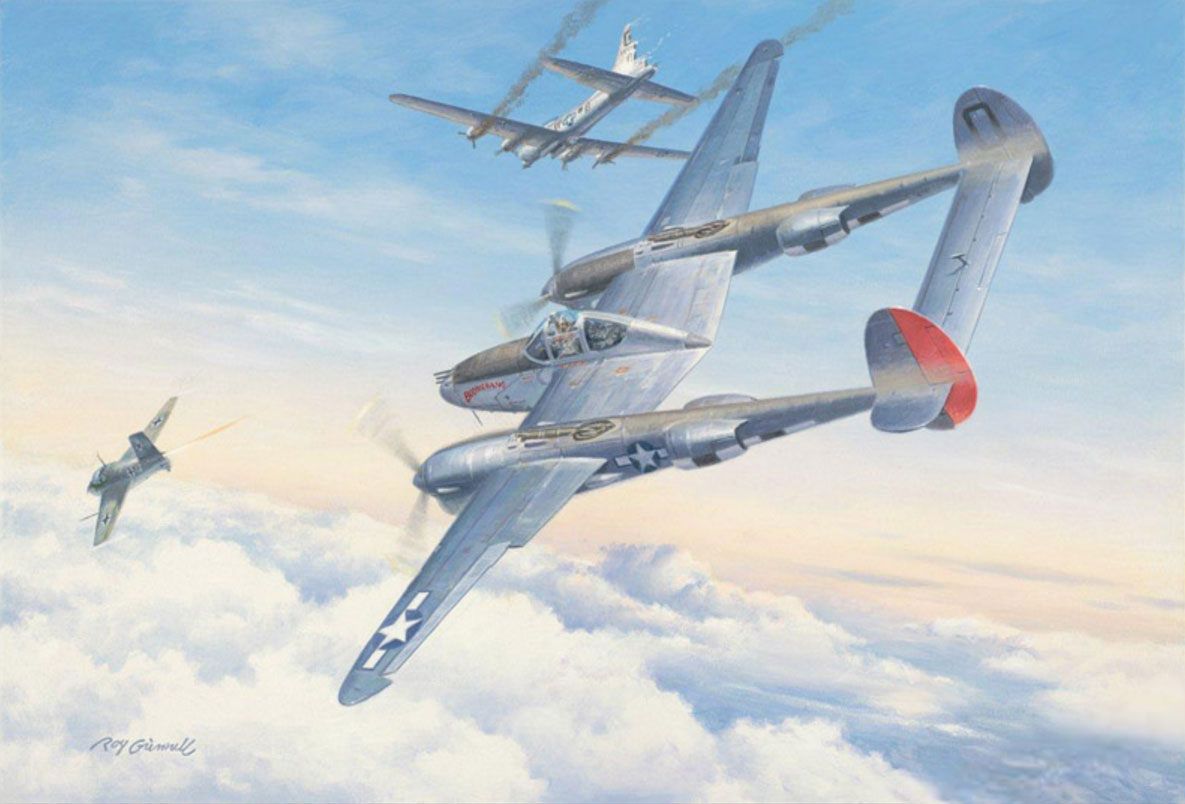
Lightning Strikes a Komet, by Roy Grinnell Having made a pass at the bomber, the rocket pilot pulled up. “I closed with him and opened fire, observing strikes on the Me 163,” Jeffrey reported. The pilot was likely 1 Staffel’s Lt. Hartmut Ryll. “Ryll had been bounced by two escort fighters,” remembered Komet test pilot Karl “Mano” Ziegler, “and, as his rocket motor had already cut, he could do nothing but go into a steep dive to shake them off.” “He rolled over and went straight down, with me fire-walled behind him,” Jeffrey remembered. “...I was shooting at him as I was going straight down, and my tracer path was walking forward of the ’bat’. Then I got into an arc of an outside loop, and when I finally pulled out a few hundred feet above the ground, I blacked out.” Jeffrey’s wingman, Lt. Richard G. Simpson, confirmed, “The Me 163 went into the clouds, which were at around 3000 ft, still in a dive of 80 degrees or better. He must have been indicating 550-600 mph, and showed no signs of pulling out. I don’t see how the German could have gotten out of that dive.” Jeffrey claimed a probable, and was famously awarded the first rocket-fighter kill of the war, but the Germans actually recorded no Komets lost or even damaged that day. The 163 was so slippery that, even with its engine off and tanks empty, it could out-plummet Allied fighters on diving full power, and pull out later too. (Lightning pilots were actually forbidden to power-dive because compressibility might tear the tail off their airplane.) “Naturally, you have to keep you nerve, keep the airplane in a vertical dive, and then, with your chin tucked in for support, pull hard to level out,” reported Ryll. “Our bird hangs in there, steady as a rock. The Americans break off their attack relatively early. And by the time the airspeed dissipates back out of the 900km/h area, you’re already back in the local area and under the protection of our own flak.” On August 16th nearly 1,100 B-17s and B-24s passed Brandis on their way to targets further east. Feldwebel Herbert Straznicky made a tail pass on B-17 XK-H, Towering Titan, was hit and wounded. He bailed out. Ryll so badly shot up a B-17 of the 305th Bomb Group—waist gunner and ball turret gunner killed, tail gunner bailed out—that it was claimed as a kill, though it would struggle back to England. Ryll then homed in on a straggling B-17 of the 91st BG, Outhouse Mouse, but 359th FG Lt. Col. John B. Murphy anticipated his move: “He passed through the bombers and down to the straggling B-17 and arrived before I could; however, I wasn’t far behind and was overtaking.... I opened fire from about 1,000 feet and held it until I overshot. I scored a few hits on the left side of the fuselage.” Before Ryll could complete a rollover and dive, Murphy’s wingman, Lt. Cyril W. Jones Jr., made a firing pass. “The entire canopy seemed to dissolve on the enemy aircraft...the pilot was surely killed.” The 163 spiraled down. Murphy turned back inside it, “seeing continuous strikes the full length of the fuselage. Parts began falling off, followed by a big explosion and more parts falling off. I could smell a strange chemical fume in my cockpit as I followed through the smoke from the explosion.” Ryll did not survive.
The bombers did not return for eight days, but on August 24 over 1,300 B-17s and B-24s arrived at 21,000 feet plus. Schubert and Lt. Hans Bott led two pairs of Komets up past 36,000 feet, shut off their rockets and dived to the attack. Schubert targeted the leader of a 92nd BG formation. He shot up its left wing so badly that it fell out of formation and would not return to England. Bott, flying one of the early Komets with 20mm cannons, took on another B-17 off to the left: “As soon as I began firing my MG 151 machine guns one of them jammed but the other continued to fire and I saw my shells hit the aircraft.” Flak crews confirmed Bott’s B-17 crashed. He was airborne just seven minutes. 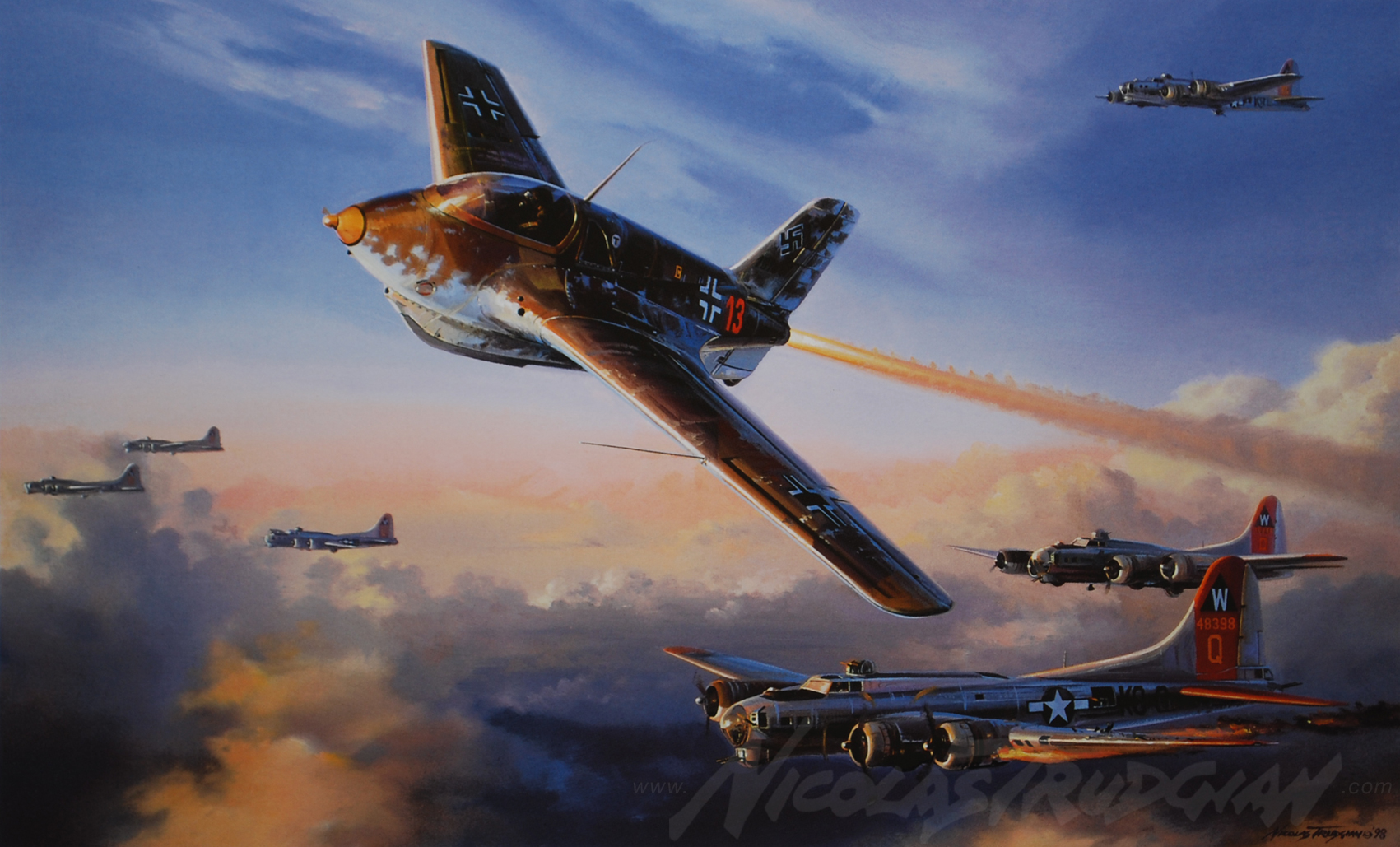
Rocket Attack by Nicolas Trudgian Buy the print Meanwhile Schubert’s dive had put him in the critical Mach zone. To bleed off speed, he pulled up in front of the 457th BG, winged over and came back down from their 12 o’clock high. Targeting the No. 3 in the lead formation at 25,000 feet, his head-on pass allowed for a few hits, but Schubert looped back again for a tail attack. “With just three shots of his two MK-108s,” Späte learned, “he cleanly separated the entire tail section of a Flying Fortress.” The bomber exploded at about 11,000 feet. On Sept. 11, a straggling B-17 passed almost over Brandis. Kurt Schiebeler scrambled up in a Komet. With time to make multiple passes, the Komet was a match for a bomber: “During my third gliding attack, my shells hit the starboard, inboard engine. On my fourth gliding attack I raked the aircraft between the starboard engine and the fuselage.... A voice from the command post called out ‘Turn back. The aircraft is beginning to go down.’” (Ltn. Gustav Korff, a communications specialist from the Russian Front, served as the unit’s ground controller, pioneering new radar guidance equipment and techniques necessary to steer rocket pilots, within minutes, onto targets initially too high for them to see.) “Luckily, there wasn’t any fighter protection there at the time,” he remembered. “After my third attack, the inside engine on the enemy aircraft started smoking. But the stubborn crate continued on to the west. Finally, I got the hang of it on my fourth pass. I fired a full burst at very close range starting at the right outside engine and working into the fuselage. I saw the landing gear fall out. Then three men bailed out.” The Fortress crashed within ten kilometers of Brandis. 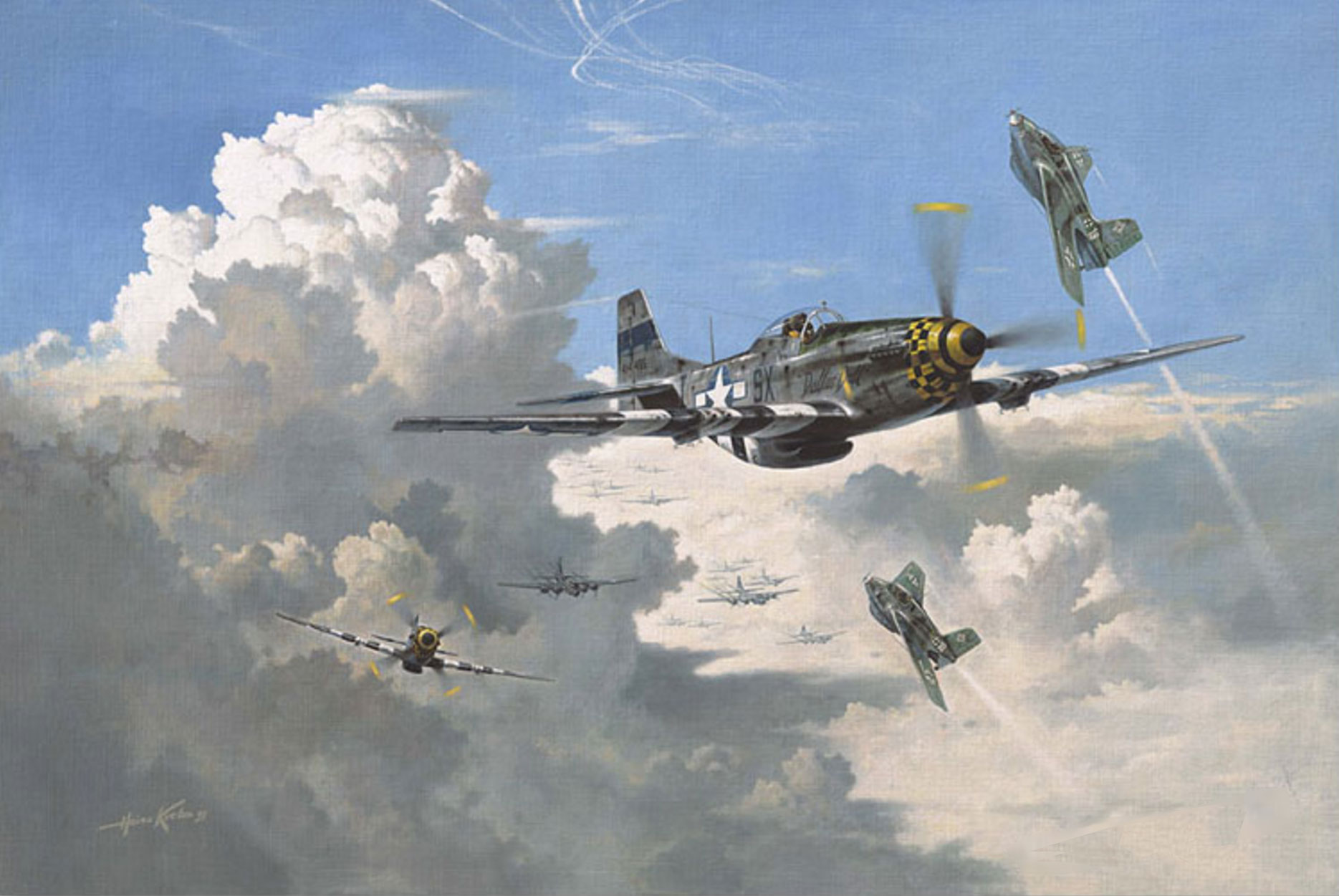
Playing the Last Ace, by by Heinz Krebs Me-163 Komet fighters climb vertically through an 8th Air Force bomber formation and P-51 Mustang fighter cover before swooping down to attack the “heavies.” “The next day, he shot down another one in flames over Merseburg without being able to confirm the crash,” remembered Späte, “...After that, we experienced a series of failures and aircraft losses.... The 7th of October was a terrible day of desperation!” At noon Schubert and Bott led as many as 20 Komets in a mass scramble. Schubert made a three o’clock pass on a 95th BG B-17, had his tail shot up and spun away. Bott blew a five-foot section out of a 92nd BG Fortress’s right wing and would claim it as a kill. Then Schubert was back, making a head-on pass on the 457th BG. With time for just one burst, he made it count. A B-17 spun down, shedding six parachutes. Schubert’s third kill made him the leading rocket-fighter pilot of the war. Top-scoring rocket-fighter pilot of all time Sgt. Siegfried Schubert (Silent) 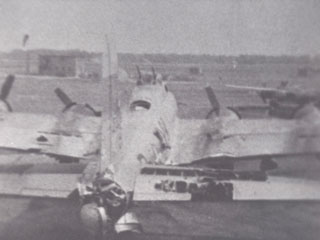
Lt. Charles Laverdiere’s B-17 XK-B of the 305th Bomb Group after its return to Chesterton, UK, 8-24-44. Damage often attributed to Ryll, but consistent with Schubert’s gun-camera film. Me-163 gun camera film, 8-24-44
He and Bott returned to Brandis, where another pair of Komets were ready for them. Oberfeldwebel Friedrich-Peter “Fritz” Husser, queued up to take off after them, saw what happened next. “Schubert was about 50 meters ahead of Bott. Suddenly, flames shot out from Schubert’s Me 163: the rocket’s combustion chamber had caught fire.” “Halfway along the runway, the engine in Schubert’s aircraft cut out,” remembered Unteroffizier Rolf Glogner, waiting last in line, “and he rolled onto the grass to get out of the way of the other aircraft which were following him. One of his wings touched the ground and his aircraft somersaulted and then exploded just as the aircraft flown by Bott passed him.” “During the rollout from his abort,” Späte learned, “the airplane rolled into a newly sodded area of the airfield and flipped over. It disintegrated within seconds into the now very familiar dark gray cloud of smoke, exploding into little pieces of shrapnel.” 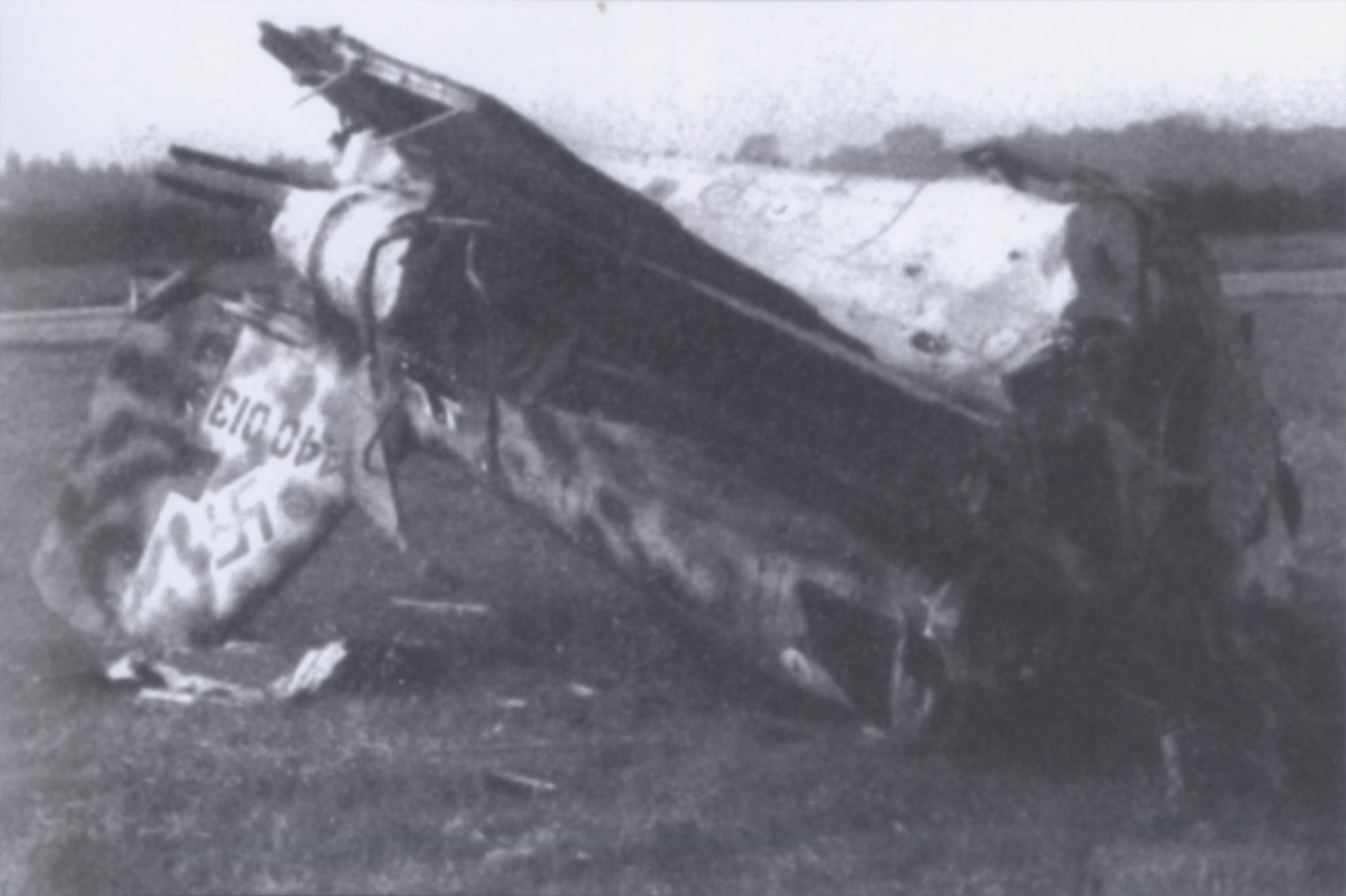
The crashed Me-163B of Unteroffizier Manfred Eisenmann, Oct. 7, 1944. Oberfeldwebel Friedrich “Fritz” Husser and his wingman, Unteroffizier Manfred Eisenmann, had to take off past the smoking pyre of JG400’s best pilot. On their return, scoreless, both crashed on landing. Husser was pulled from his overturned Komet, but Eisenmann’s sideslipped into the ground, breaking off its nose. “Wreckage was strewn all around,” Hermann remembered, “and we found Eisenmann dead but still strapped in his seat alongside the remains of the fuselage.” Efforts were ongoing to solve the 30mmcannon’s faults: low firing rate, high trajectory, short range, and jamming. That month, underwing racks for two dozen unguided R4M rockets were fitted to a spare 163A. Each warhead had the same explosive power as a 30mm round, and live-fire tests proved the idea feasible—a rocket-firing rocket—but the R4M also the same low speed and rainbow-like trajectory of the Mk 108 round, and was available in insufficient numbers to be useful. More promising was the SG 500 Jägerfaust, the “Fighter Fist”: ten recoilless wing guns automatically firing upward when the Komet passed under the shadow of a bomber. Its 50mm shells had the same explosive power as a German 88mm anti-aircraft round. Test runs flown at 900 km/r under a bomber-size cloth stretched 20 meters off the ground shot it to pieces, though simultaneous firing of all ten guns blew off the 163’s canopy. A slight sequential delay was built into the firing system. Meanwhile Walter was already at work on a new rocket with cruise capability and increased range. It was to be fitted into a stretched-fuselage Me-163C, but this was passed over in favor of an even more advanced Me-163D with retractable landing gear, and finally a Me-263 with cruise rocket, wheels, and pressurized cockpit. Only three prototypes, however, were complete by war’s end. 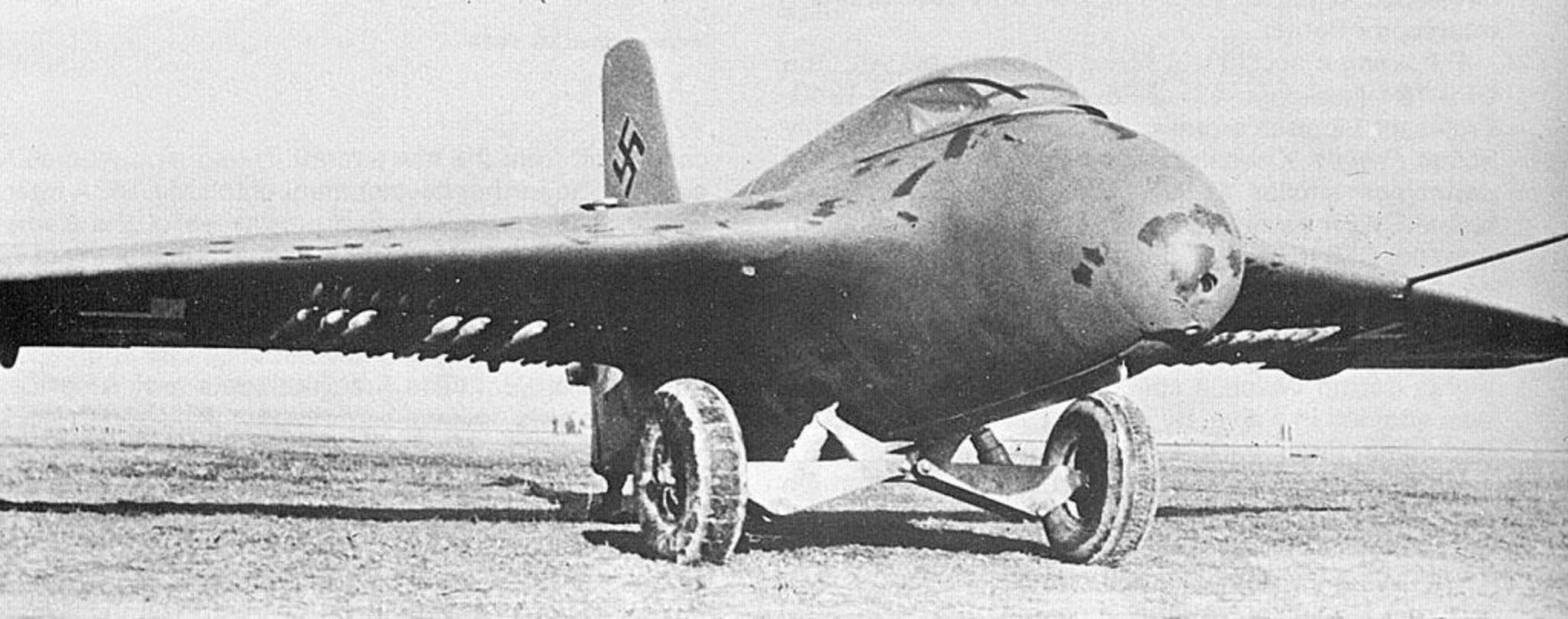
Me-163A with 24 R4M rockets The R4M was developed to offset the increasing weight of German aircraft guns capable of downing Allied bombers, specifically the 30 mm MK 108 cannon. Although each rocket was heavier than a 30mm shell, 24 rockets weighed less than the gun plus its usual 65 rounds. The R4M had a similar trajectory to the 30 mm rounds, requiring no change to the standard Revi 16B gunsight. 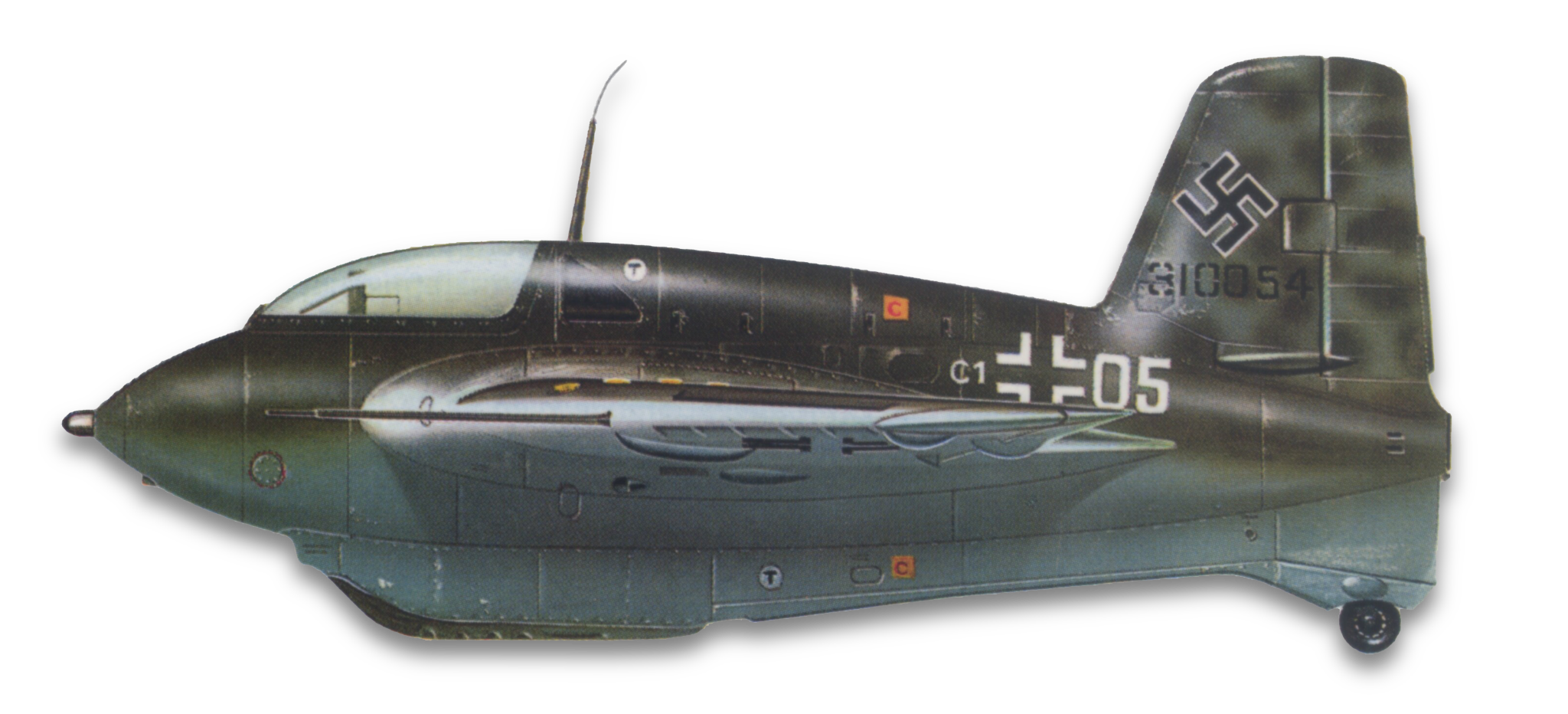
Me-163B-0 V45 Used for trials of the wing-installed, upward-firing, recoilless 50mm Jägerfaust mortar. Aircraft was badly damaged when simultaneous firing of all 10 projectiles blew off the canopy. 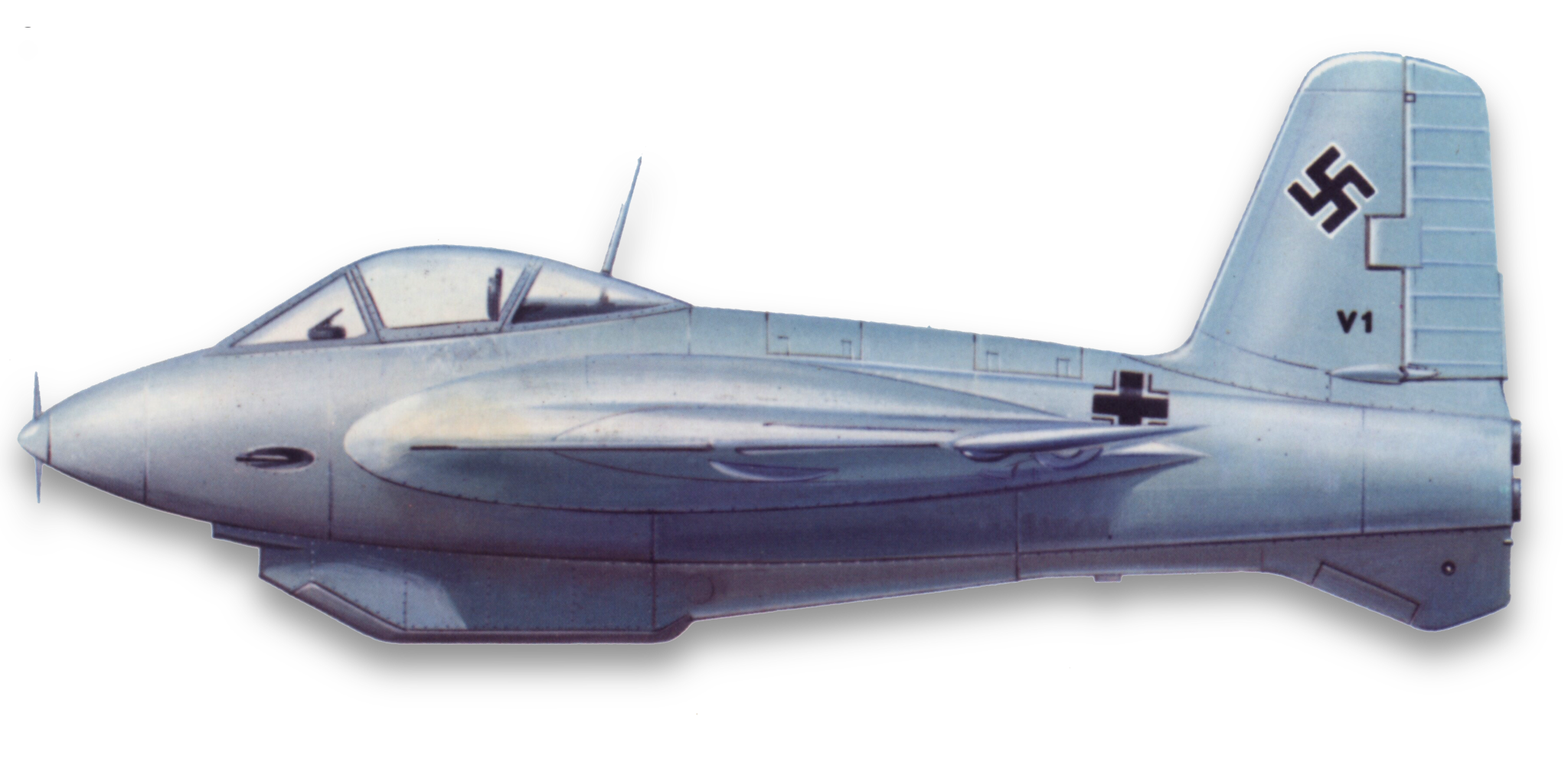
Me-163C To accomodate the new twin-chamber Walter rocket with cruise capability, Messerschmitt extended the 163B fuselage, added extra tank capacity and a new pressurized cockpit topped with a bubble canopy. 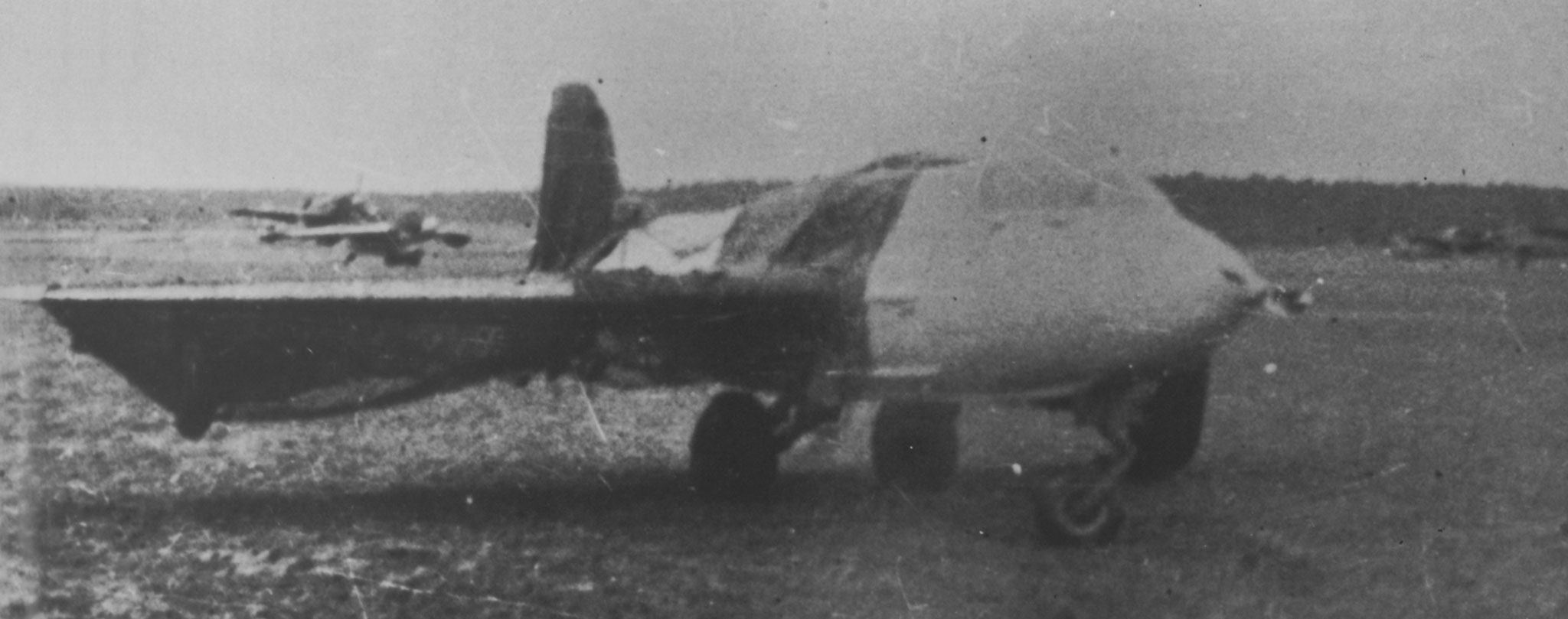
Me-163C Shown with B-type canopy. Maximum altitude increased to 52,000 ft, powered flight time to about 12 minutes, and combat time from about five minutes to nine. Three prototypes were planned, but only one was flown, and without its cruise rocket. 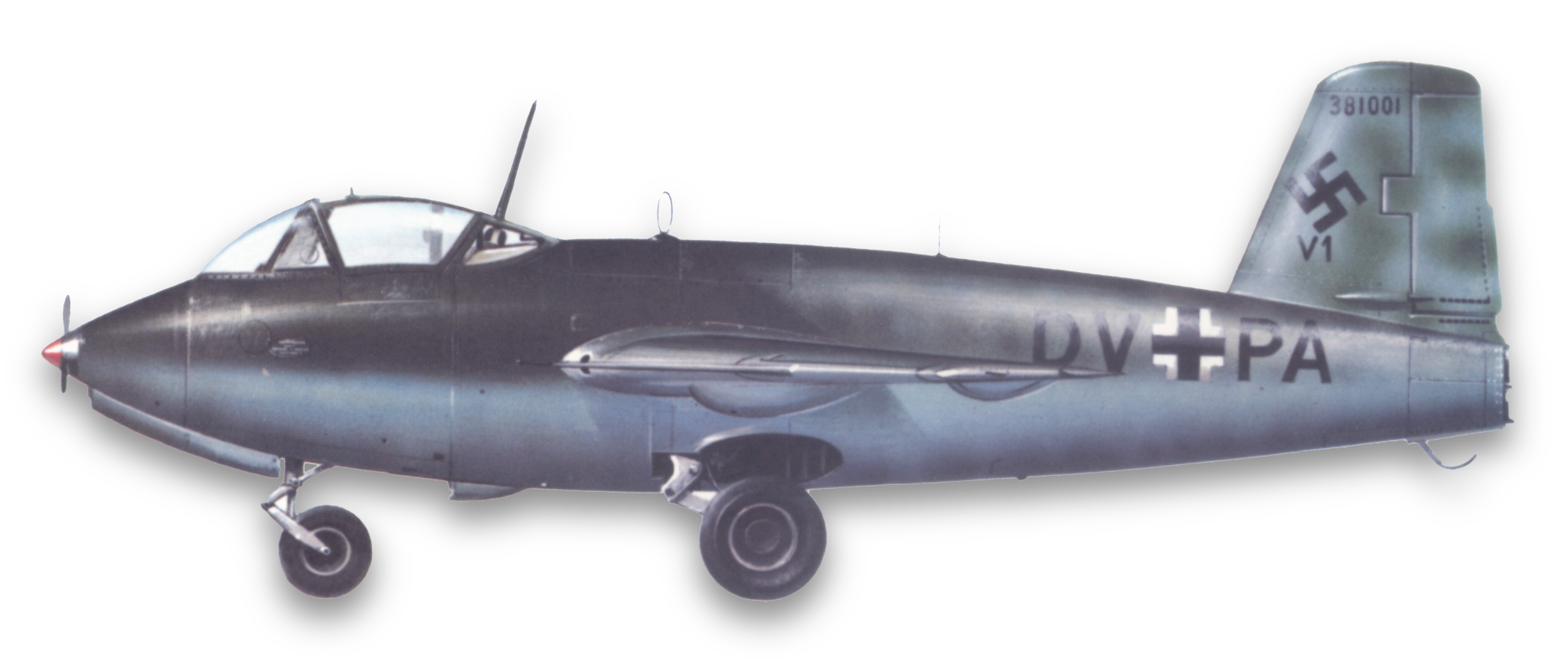
Me-263 (Ju 248) Fitted with tricycle gear and twin-chamber Walter cruise rocket (though the gear was probably not retractable in testing), the Junkers Ju 248 used a three-section fuselage to ease construction. The prototype was completed in August 1944 and glider-tested behind a Junkers Ju 188 but probably never tested under power. 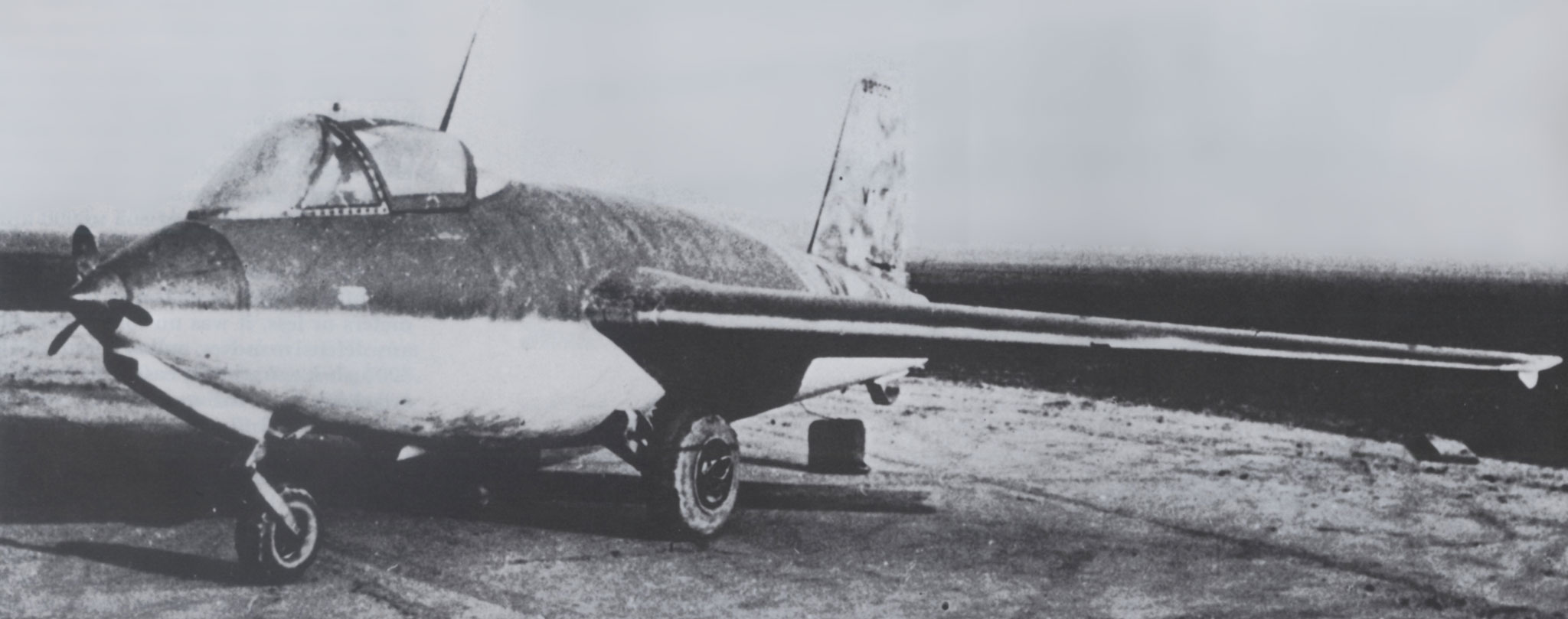
Me-263 (Ju 248) Though designated Messerschmitt Me 263, Junkers continued development of three prototypes before the plant was overrun by the Russians. The Soviets briefly developed the design as the Mikoyan-Gurevich I-270, which was discontinued after two prototypes crashed. Note three-blade generator prop.
Captured Bachem Natters undergoing inspection by US troops. St. Leonhard im Pitztal, Tyrol, Austria, May 1945 With the Komet in perpetual development, and facing a critical shortage of C-Stoff fuel for JG400, Colonel Wolfgang Späte was told by General of Fighters Adolf Galland, “...because of a special SS initiative, a defensive surface-to-air rocket aircraft is supposed to be forced into production. And they will be propelled by C-Agent as well. That is the height of stupidity, but it’s also fact.” In July 1944 the Luftwaffe established a Jägernotprogramm, Fighter Emergency Program: a quick and dirty solution to the Allied bombers pummeling Germany. Engineer Erich Bachem’s Ba 349 Natter (“Snake”) would operate more like a guided missile: a vertical-takeoff, semi-disposable manned rocket. The Luftwaffe rejected the concept, so Bachem put it in front of Heinrich Himmler. The Reichsführer-SS, desiring to give his personal army some air power, approved the idea. 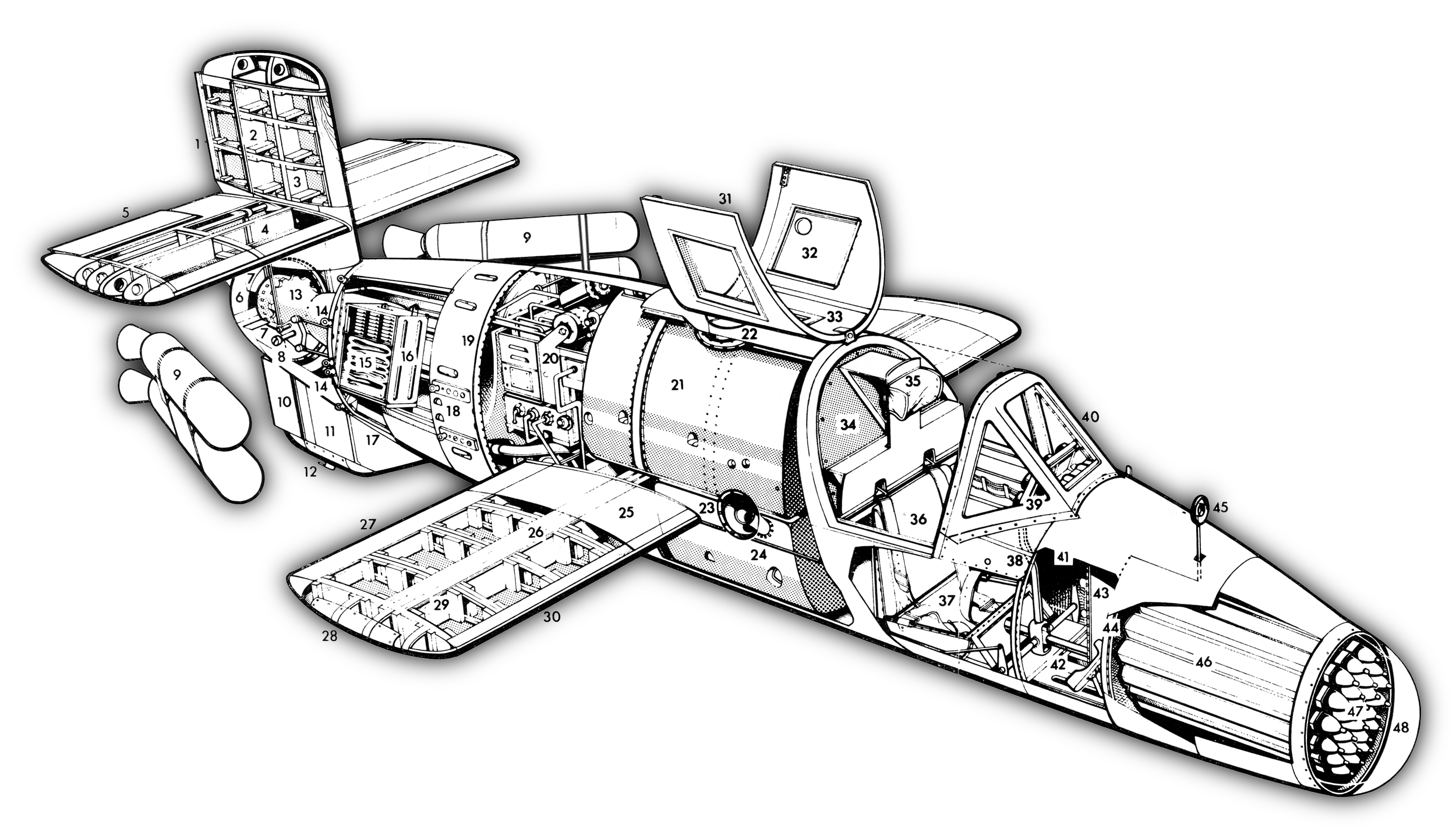
Bachem BA-349 Natter
1 Rudder
17 Parachute exit hatch
33 Roof glazing The Natter was intended to be crudely built by unskilled labor using wood, glue, and nails. The wings were simple wooden blades, with all control surfaces on the cruciform tail. Because the Walter rocket hadn’t the power to launch a fully loaded Natter straight up, four solid-fuel boosters would provide 10,500 extra pounds of thrust for ten seconds, until the main engine built up enough thrust to climb at 37,000 feet per minute. At first the idea was to ram enemy bombers with a concrete nosecone, but eventually that became a Perspex cap over as many as two-dozen R4M rockets. After firing them, the pilot would release the disposable nose section and a brake parachute. The sudden deceleration would kick him loose from the rocket section. They would descend under separate ’chutes. The BA 349 required no landing gear, no runways, no huge manufacturing commitment, and hardly any development time. The first prototype was ready in October, towed glide tests were flown in November, and an unmanned test launched three days before Christmas. A second test in January with a dummy pilot was also successful, though the rocket’s leftover T-Stoff and C-Stoff exploded on touchdown. As the pilot would have landed safely clear of the blast, plans went ahead for a manned test. 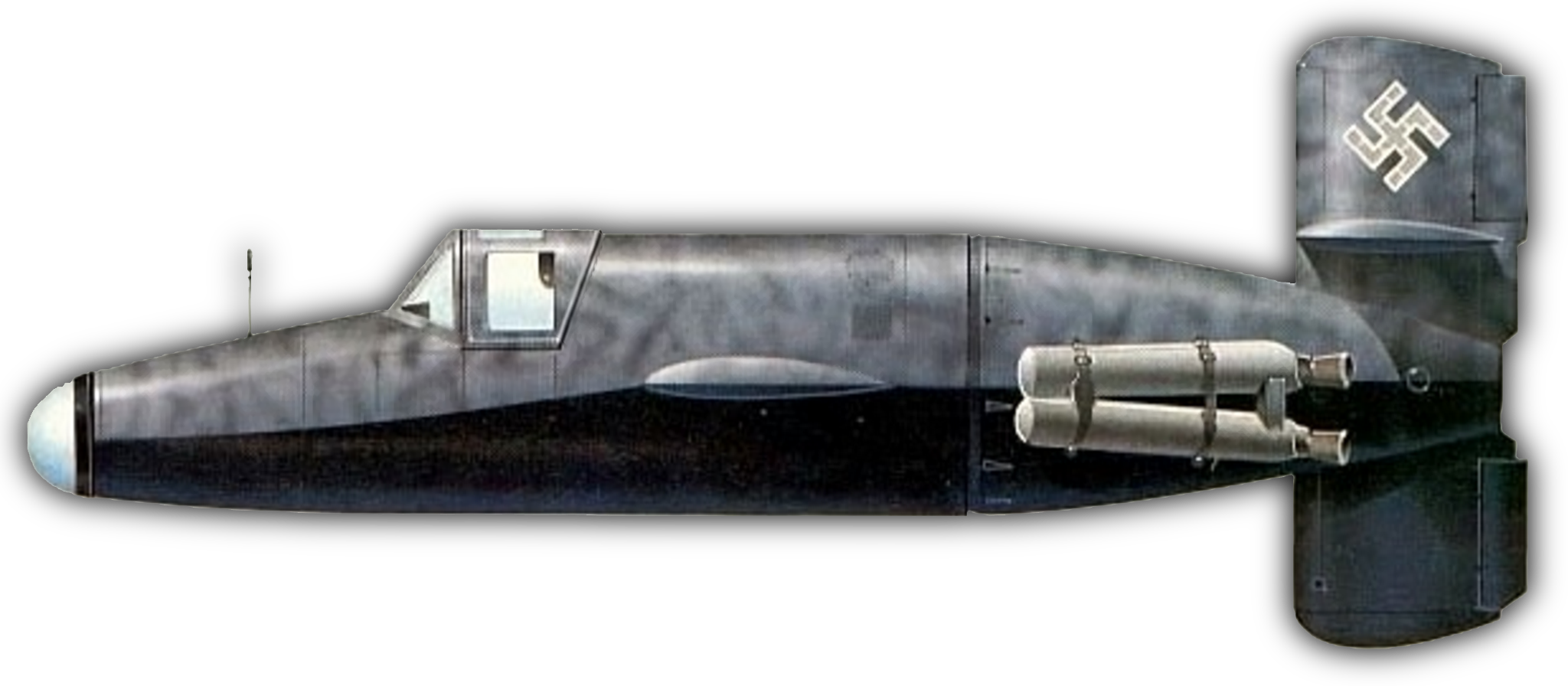
Bachem BA-349 Natter Experienced Arado Ar-232 test pilot Lothar Sieber signed on for the first vertical-takeoff manned rocket flight, on March 1, 1945. On cue, the Natter rose from its launch tower on a pillar of smoke and steam, but before it passed 500 feet something went wrong. It pitched over backward. Its canopy flew off. Climbing inverted, it disappeared into the clouds, and less than sixty seconds later came hurtling back down, still under full power, to hit the ground about five miles away with Sieber still inside. He may have been pinned in the cockpit by G forces, or knocked unconscious or dead when the canopy flew back. If a veteran test pilot couldn’t control the Natter, it was thought, no inexperienced pilot would; the SS cancelled the project. But like the Komet, the Natter broke new ground, if at high cost. Sieber was not only the first vertical-rocket pilot, but likely the first man to break the sound barrier. 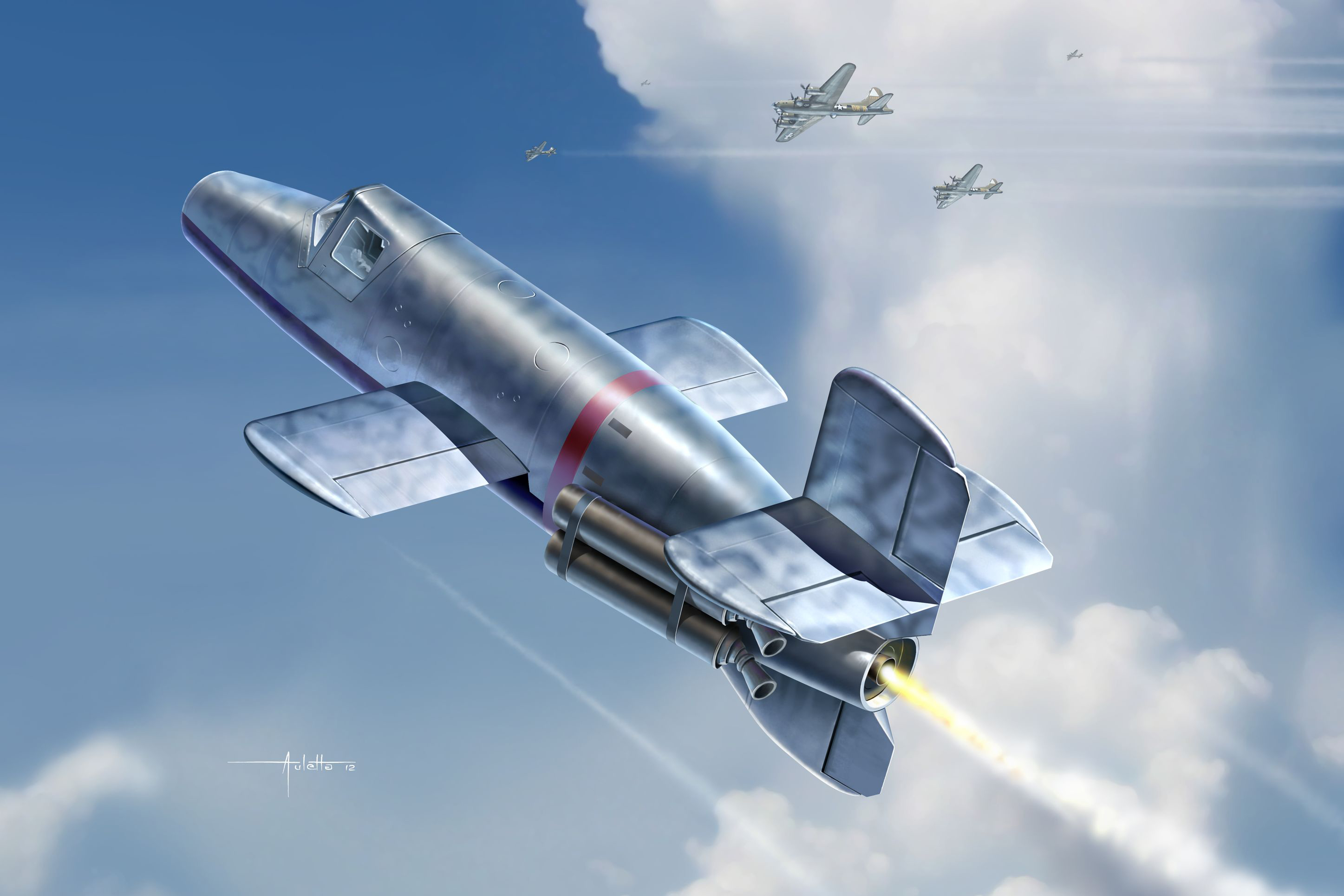
Bachem BA-349 Natter by Vincenzo Auletta Given more development time, the Natter might have presented Allied bombers with a second rocket threat
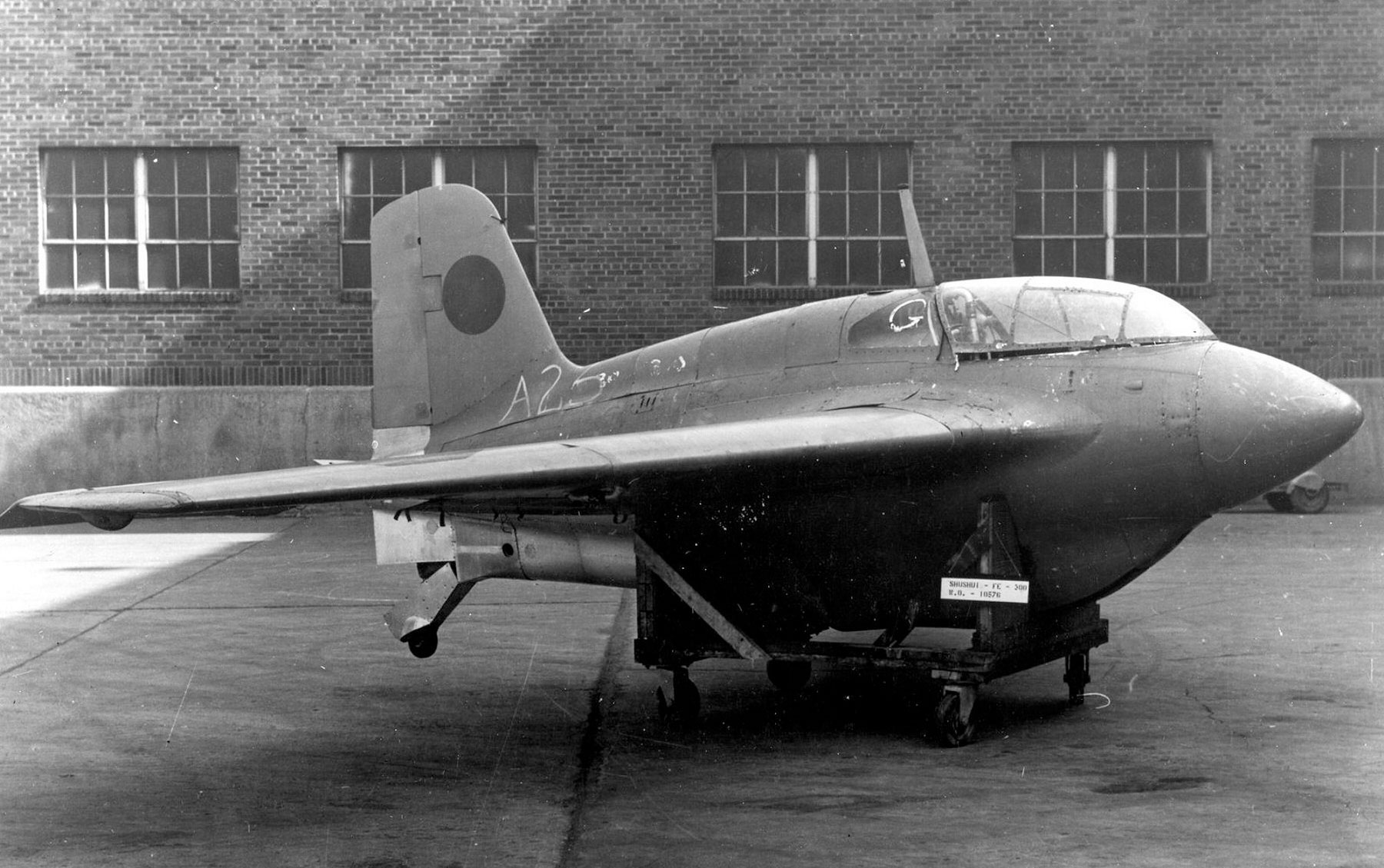
Mitsubishi J8M1 Shusui Rocket fighters also appealed to Germany’s B-29-beset allies, the Japanese. Though various plans and components were lost in transit aboard sunken U-boats, they developed their own license-built Komet, the Shusui (“Powerful Sword”). On its first powered test on July 7, 1945, however, the prototype’s engine cut out. It crashed. Pilot Toyohiko Inuzuka was killed. 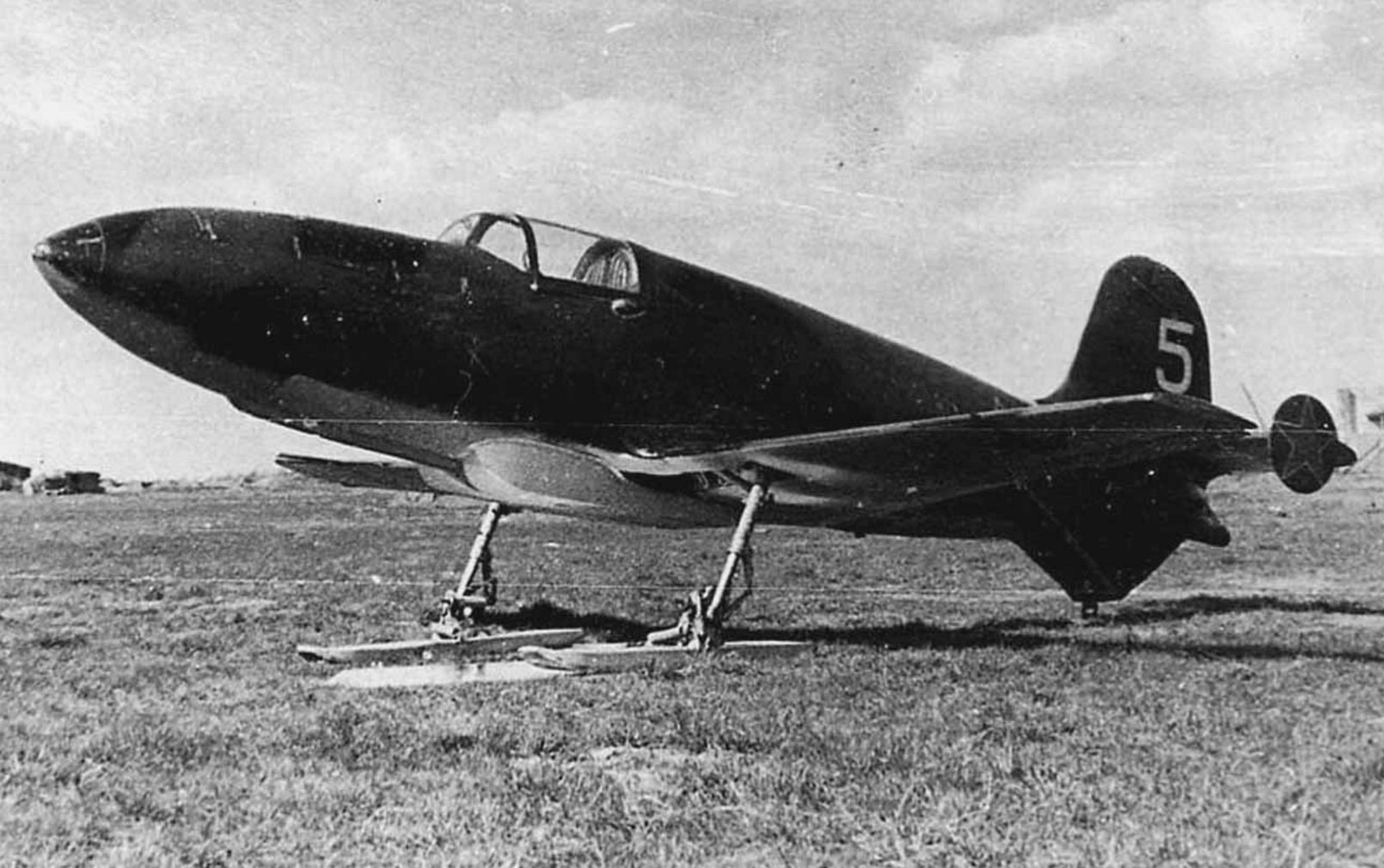
Bereznyak-Isayev BI The Soviet BI was of more conventional layout than the Komet, but its rocket, burning kerosene and red fuming nitric acid, was no more reliable and contributed to airframe corrosion. One pilot was slightly wounded in a motor explosion and another killed in a crash when he lost control near the sound barrier. The BI never saw combat. Like the Germans, the Russians became more enamored of jets. That fall and winter saw little activity for JG400 pilots. The Americans had learned that to avoid rocket fighters, they had merely to avoid Brandis. Belatedly recalled from the Russian Front and put back in command, Späte wasted no time dispatching two staffeln to Stargard, near Stettin, with Opitz as group commander. Business there was even slower; the unit flew only three combat missions before the field was overrun by advancing Russians. And Germany’s sole C-Stoff plant, at Kiel, had been obliterated. “Our only supply of T-Agent and C-Agent,” Späte was told, “is what’s left in storage at the different airfields and depots. We have enough here at Brandis for about another 50 fully loaded flights.” 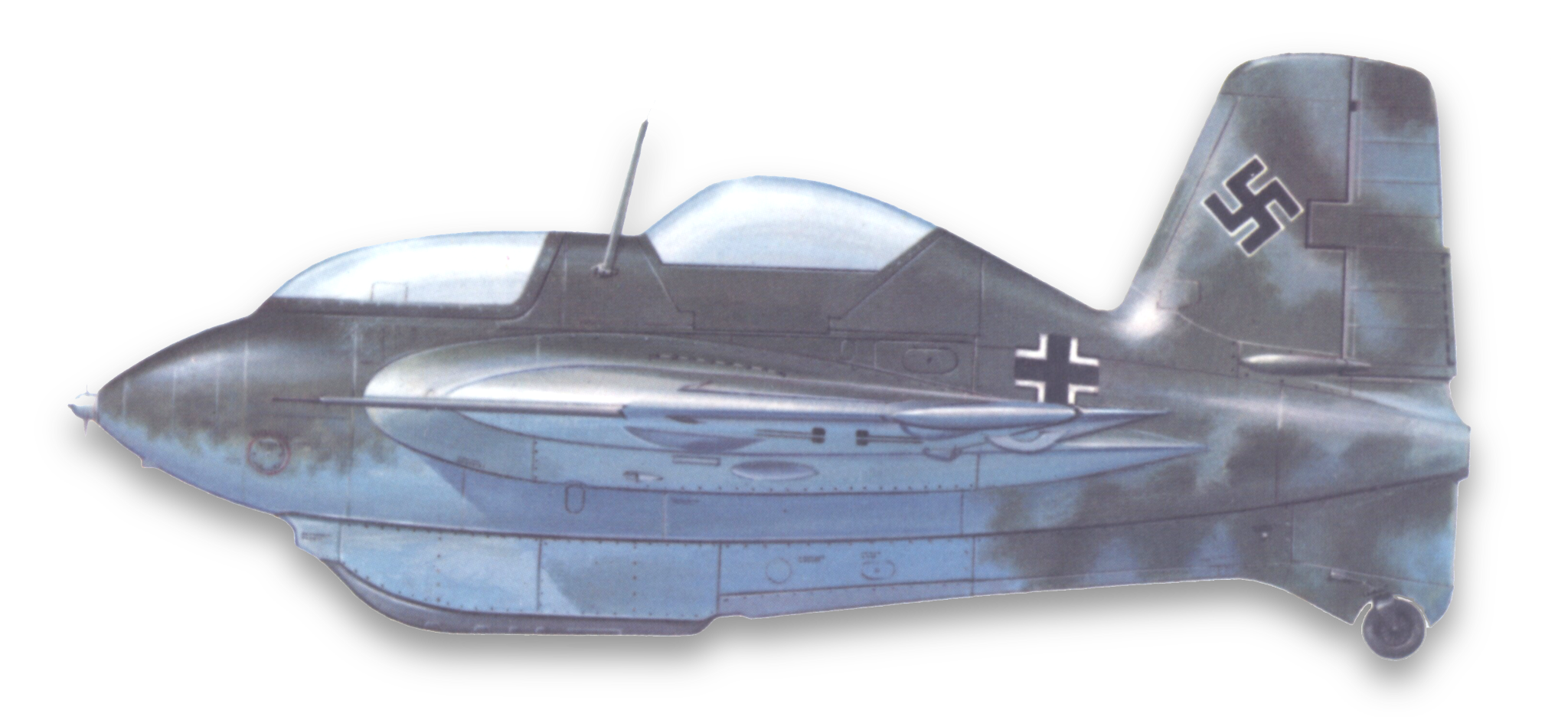
Me-163S Several 163B models had their rockets and fuel tanks deleted to make two-seat trainers, with the instructor in the rear seat and water in the fuel tanks to simulate changing fuel load. The Russians took at least one of these back to the USSR after the war. Lack of fuel meant lack of training. “Unfortunately, many of our newly trained fighter pilots don’t have enough nerve to even stand the excitement of a powered takeoff without getting their underwear dirty,” Schiebeler told Späte. On February 22nd over 1,400 bombers pounded 25 targets around Brandis, but only seven Komets were capable of scrambling. None of their pilots so much as found a target. Combat missions were limited to lone Allied reconnaissance aircraft; the Komet was one of the few German planes that could, and did, catch RAF Mosquitos in level flight. The toll in Komet pilots having far outweighed their results in combat-and with far more lost to accidents than to enemy action-that same month Germany ceased 163 manufacture. 364 had been built, less than 25% of which saw fighting. 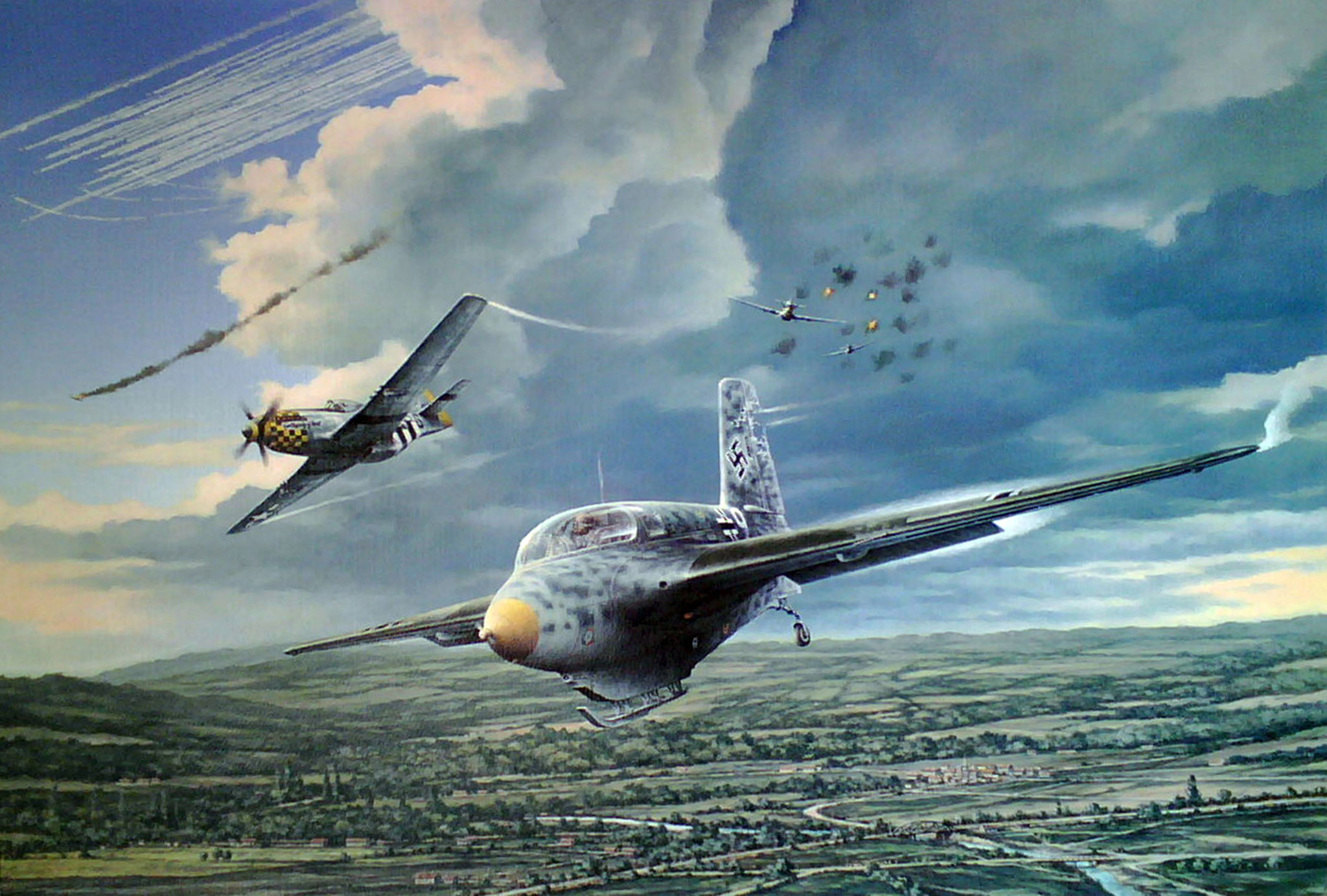
Baptism of Fire, by Marii Chernev Brandis, August 1944: As Unteroffizier Kurt Schiebeler flees for home in Messerschmitt Me-163B V53, W.Nr. 16310062 “White 9,” P-51 Mustangs of the 353th Fighter Group brave German flak to give chase. Once on approach, a rocket pilot was powerless to evade. Schiebeler survived the war. “White 9” was blown up by the Germans at Brandis in a futile attempt to keep rocket technology out of Allied hands. Before the end Lt. Fritz Kelb dared to fly one equipped with the Jägerfaust. On the evening of April 10th, personnel at Brandis watched him speed up toward 100 bombers attacking Leipzig. “Kelb approached the lead aircraft of the bomber formation and flew by underneath the bomber at very close range,” Späte remembered. “At that instant, the bomber disappeared in a cloud of smoke and flames.” Kelb was jumped by Mustangs, but put the Komet’s nose down and ran for home. “He had received a lot of hits on the top side of the airplane...shrapnel from the giant explosion which had blown his target to bits. This was the one and only time that this weapons system was used in the air.... ’Too late!’” Opitz flew one of the last Komet missions of the war. He lost power, crash-landed, and broke his shoulder and several ribs. “He married his nurse,” Späte wrote, “and lived happily ever after.” Heini Dittmar died in a gliding accident in April 1960. Lippisch and Walter emigrated to the States. Lippisch worked for Convair, where his work showed in the design of the F-102 Delta Dagger, F-106 Delta Dart and B-58 Hustler. Walter’s rocket technology set the example for the legendary X-planes which broke the sound barrier, times seven. To this day, however, their Me-163 remains the only rocket-powered combat aircraft. Its pilots had the satisfaction of knowing they did what few get to do: fly the hottest airplane in the sky.
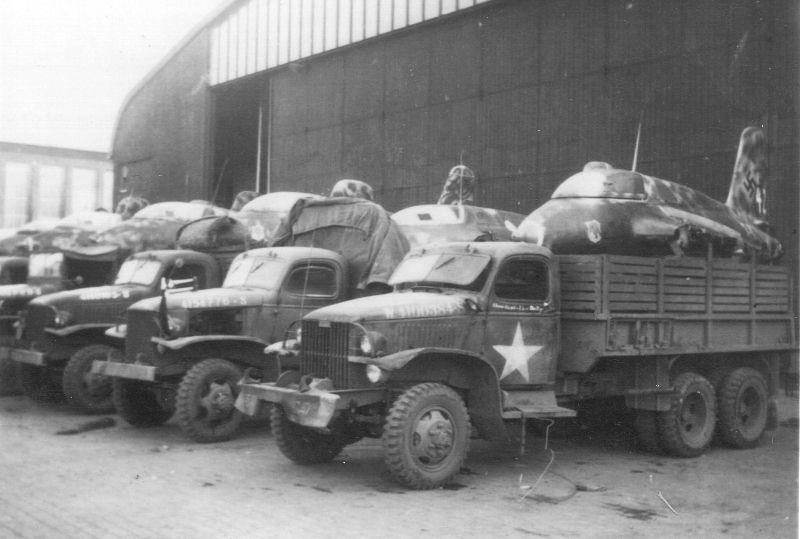
Seven GMC 2½-ton 6x6 Jimmy trucks with Me-163B Komets bound for the US. Possibly Merseburg, Germany. 
Captured Me-163 gets a tow from a B-29 Superfortress. In the final weeks of the war B-17 pilot Edward F. Reibold was startled to find an Me-163 flying his port wing, just out of range. “Without changing direction, he slid into within a few feet of our left wing tip,” he remembered. “We were, at the time, traveling at an airspeed of approximately 285mph. The pilot of the German plane hesitated off our wing, nodded, threw us a ‘Highball’, pushed his throttle forward and accelerated forward in flight leaving us ‘standing’ in mid air.” To this day the Me-163 Komet remains history’s only rocket-powered combat aircraft. Its pilots—those who survived—had the satisfaction of knowing that, if they hadn’t changed the course of the war, they nevertheless flew the hottest airplane in the sky. “They were all filled with an intractable urge to serve their Fatherland in a special way,” remembered Späte. “... They were ready to give their lives in order to fulfill their dream of flying in a rocket.”
Comments loading....
|
